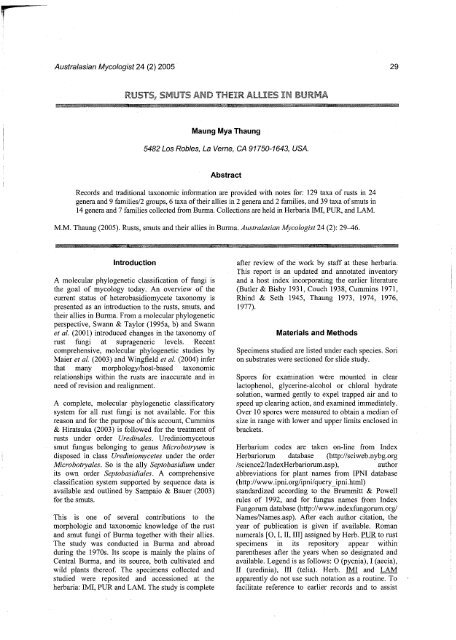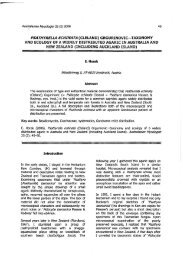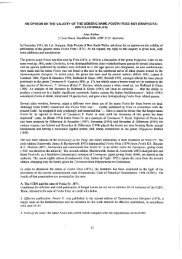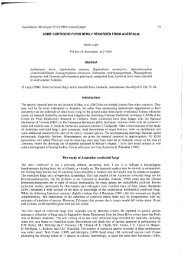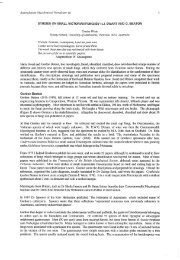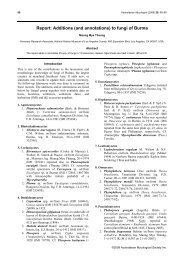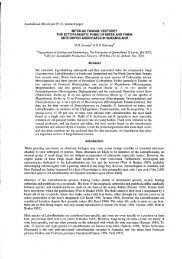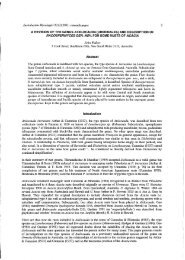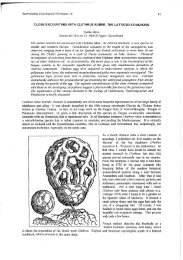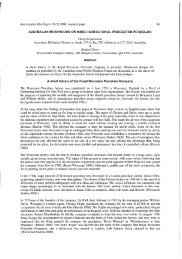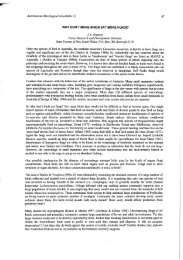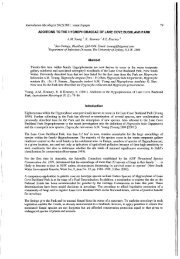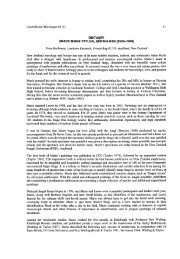rusts, smut? - The Australasian Mycological Society
rusts, smut? - The Australasian Mycological Society
rusts, smut? - The Australasian Mycological Society
You also want an ePaper? Increase the reach of your titles
YUMPU automatically turns print PDFs into web optimized ePapers that Google loves.
RUSTS, SMUT? THEIR ALLIES O PJJRMA<br />
introduction<br />
A molecular phylogenetic classification of fungi is<br />
the goal of mycology today. An overview of the<br />
current status of heterobasidiomycete taxonomy is<br />
presented as an introduction to the <strong>rusts</strong>, <strong>smut</strong>s, and<br />
their allies in Burma. From a molecular phylogenetic<br />
perspective, Swann & Taylor (1995a, b) and Swann<br />
et al. (2001) introduced changes in the taxonomy of<br />
rust fungi at suprageneric levels. Recent<br />
comprehensive, molecular phylogenetic studies by<br />
Maier et al. (2003) and Wingfield et al. (2004) infer<br />
that many morphology/host-based taxonomic<br />
relationships within the <strong>rusts</strong> are inaccurate and in<br />
need of revision and realignment.<br />
A complete, molecular phylogenetic classificatory<br />
system for all rust fungi is not available. For this<br />
reason and for the purpose of this account, Cummins<br />
& Hiratsuka (2003) is followed for the treatment of<br />
<strong>rusts</strong> under order Uredinales. Urediniomycetous<br />
<strong>smut</strong> fungus belonging to genus Microbotryum is<br />
disposed in class Urediniomycetes under the order<br />
Microbotryales. So is the ally Septobasidium under<br />
its own order Septobasidiales. A comprehensive<br />
classification system supported by sequence data is<br />
available and outlined by Sampaio & Bauer (2003)<br />
for the <strong>smut</strong>s.<br />
This is one of several contributions to the<br />
morphologic and taxonomic knowledge of the rust<br />
and <strong>smut</strong> fungi of Burma together with their allies.<br />
<strong>The</strong> study was conducted in Burma and abroad<br />
during the 1970s. Its scope is mainly the plains of<br />
Central Burma, and its source, both cultivated and<br />
wild plants thereof. <strong>The</strong> specimens collected and<br />
studied were reposited and accessioned at the<br />
herbaria: IMI, PUR and LAM. <strong>The</strong> study is complete<br />
Maung Mya Thaung<br />
5482 Los Robles, La Verne, CA 91750-1643, USA.<br />
Abstract<br />
Records and traditional taxonomic information are provided with notes for: 129 taxa of <strong>rusts</strong> in 24<br />
genera and 9 families/2 groups, 6 taxa of their allies in 2 genera and 2 families, and 39 taxa of <strong>smut</strong>s in<br />
14 genera and 7 families collected from Burma. Collections are held in Herbaria DVII, PUR, and LAM.<br />
M.M. Thaung (2005). Rusts, <strong>smut</strong>s and their allies in Burma. <strong>Australasian</strong> Mycologist 24 (2): 29^16.<br />
after review of the work by staff at these herbaria.<br />
This report is an updated and annotated inventory<br />
and a host index incorporating the earlier literature<br />
(Butler & Bisby 1931, Couch 1938, Cummins 1971,<br />
Rhind & Seth 1945, Thaung 1973, 1974, 1976,<br />
1977).<br />
Materials and Methods<br />
Specimens studied are listed under each species. Sori<br />
on substrates were sectioned for slide study.<br />
Spores for examination were mounted in clear<br />
lactophenol, glycerine-alcohol or chloral hydrate<br />
solution, warmed gently to expel trapped air and to<br />
speed up clearing action, and examined immediately.<br />
Over 10 spores were measured to obtain a median of<br />
size in range with lower and upper limits enclosed in<br />
brackets.<br />
Herbarium codes are taken on-line from Index<br />
Herbariorum database (http://sciweb.nybg.org<br />
/science2/IndexHerbariorum.asp), author<br />
abbreviations for plant names from IPNI database<br />
(http ://www. ipni.org/ipni/query_ipni .html)<br />
standardized according to the Brummitt & Powell<br />
rules of 1992, and for fungus names from Index<br />
Fungorum database (http://www.indexfungorum.org/<br />
Names/Names.asp). After each author citation, the<br />
year of publication is given if available. Roman<br />
numerals [O, I, II, III] assigned by Herb. PUR to rust<br />
specimens in its repository appear within<br />
parentheses after the years when so designated and<br />
available. Legend is as follows: O (pycnia), I (aecia),<br />
II (uredinia), III (telia). Herb. MI and LAM<br />
apparently do not use such notation as a routine. To<br />
facilitate reference to earlier records and to assist
any future revisit or revision, names mentioned in<br />
older literature are retained, if any, as synonyms<br />
with (=) identical sign in front enclosed in brackets.<br />
Notes are sometimes supplied on specimens or their<br />
fungal parasites. Classification is based on Cummins<br />
& Hiratsuka (2003) for the <strong>rusts</strong>, and follows Bauer<br />
and Oberwinkler (Sampaio & Bauer 2003) and<br />
Vanky (2002, 2004) for the <strong>smut</strong>s and their allies.<br />
Taxa are enumerated in alphabetical and hierarchical<br />
order.<br />
Taxonomy<br />
Species determined and/or recorded as<br />
present in Burma<br />
Class UREDINIOMYCETES Swann & Taylor<br />
Order UREDINALES Arthur<br />
Family CHACONIACEAE Cummins & Y. Hirats.<br />
1983<br />
1. Achrotelium ichnocarpi Syd. 1928 [II, III] on<br />
leaves of Ichnocarpus sp.; Myitnge, 14-X-1971<br />
(PUR N3865). Note: Teliospores are smaller.<br />
2. Chaconia butleri (Syd. & P. Syd.) Mains 1938<br />
[II] on leaves of Jasminum auriculatum Vahl;<br />
Maymyo, l-x-1971 (IMI 164841), (PUR<br />
F19624).<br />
3. Hemileia holarrhenae Syd. & P. Syd. 1914 on<br />
leaves of Holarrhena antidysenterica Wall.;<br />
Myitkyina, 26-xii-1971 (IMI 164836), (PUR<br />
F19620), 28-xii-1972 (LAM 2201946).<br />
4. Hemileia randiicola Thaung 1976 on leaves of<br />
Randia sp. (aff. dumetorum Lam.); North of<br />
Kyaukchaw en route Maymyo, 21-ii-1974 (IMI<br />
185232, holotype).<br />
5. Hemileia vastatrix Berk. & Broome 1869 on<br />
leaves of Coffea arabica L.; Maymyo, 1971<br />
(PUR F19619); Sinthawt village, east of Yezin,<br />
25-viii-1977 (LAM 220218a); Leiktho (Rhind &<br />
Seth 1945). Note: Hyperparasite Verticillium<br />
hemileiae Bouriquet 1946 (LAM 220218b) is<br />
also present.<br />
6. Maravalia echinulata (Niessl ex Rabenh.) Y. Ono<br />
1984 (= Scopella echinulata (Niessl) Mains<br />
1939) [II] on leaves of Madhuca longifolia<br />
Macbride; Mandalay, 20-iii-1971 (IMI 155991),<br />
27-X-1971 (IMI 161589); Madhuca latifolia<br />
Macbride; Mandalay, 28-xi-1974 (LAM<br />
220082). Note: Numerous fine paraphyses<br />
mainly clavate at the tips.<br />
7. Maravalia gentilis (Syd.) Y. Ono 1984 (=<br />
Scopella gentilis (Syd.) Mundk. & Thirum.<br />
1950) [II] on leaves of Sideroxylon sp.;<br />
Mandalay, l-x-1971 (PUR F19589), 30-X-1977<br />
(LAM 220943). Note: Germ pores tend to be<br />
higher than typical and first recorded on this<br />
host genus.<br />
8. Maravalia mimusops (Cooke) Y. Ono 1984 (=<br />
Scopella mimusops (Cooke) Cummins 1950) [II]<br />
on leaves of Mimusops elengi L.; Burma (LAM<br />
220452). Compare with Maravalia aulica (Syd.)<br />
Y. Ono 1984.<br />
9. Olivea colebrookiana Thirum. & Yadav 1955 [II]<br />
on leaves of a member (Vernacular name: Ponmagyi)<br />
of Labiatae; Fftonbo Farm, S.S.S., 12-ii-<br />
1973 (IMI 173536). Uredo colebrookiae Barclay<br />
— the uredinial stage of Olivea colebrookiana.<br />
Note: Uredinia subepidermal, erumpent, with<br />
peripheral incurved clavate paraphyses;<br />
urediniospores globoid or ovoid, pale yellow,<br />
echinulate, (16-) 19-22 (-26) x 16-17 um.<br />
10. Olivea tectonae (T.S. Ramakr. & K. Ramakr.)<br />
Thirum. 1949 [II, III] on leaves of Tectona<br />
grandis L. f.; Kyaukpadaung, 25-xii-1977 (LAM<br />
220454); (Rhind & Seth 1945). Uredo tectonae<br />
Racib. 1900 — the uredinial stage of Olivea<br />
tectonae.<br />
Family COLEOSPORIACEAE Dietel 1900<br />
1. Coleosporium tussilaginis (Pers.) Berk. 1860 (=<br />
Coleosporium campanulae Cooke 1865) on<br />
leaves of Pinus insularis Endl.; Haka, Chin<br />
Hills, 3-V-1972 (IMI 166371). Concerning the<br />
nomenclature of this species see Laundon<br />
(1967).<br />
Family MELAMPSORACEAE Dietel 1897<br />
1. Melampsora euphorbiae (C. Schub.) Castagne<br />
1843 on leaves of Euphorbia geniculata Ortega;<br />
Maymyo, 15-V-1971 (IMI 157605), 17-xii-1975<br />
(IMI 199753, LAM 220043); E. rottiana<br />
Spreng; Tadau, l-iv-1972 (IMI 166362), 11-ii-<br />
1973 (LAM 220216); Myaung, 2-iii-1973 (IMI<br />
173547). Synonymy: Uredo euphorbiae<br />
(C. Schub.) Castagne. Based on host, this taxon<br />
could possibly be Melampsora euphorbiaegeniculatae<br />
F. Kern & Thurst. 1944. Note:<br />
Urediniospores 16-24 x 13-18 urn ; walls 2-<br />
3 um ; paraphyses capitate 19—24 x 16-22 um.<br />
2. Melampsora ricini E.A. Noronha 1952 (formerly<br />
as Melampsora euphorbiae (C. Schub.)<br />
Castagne) on leaves of Ricinus communis L.;<br />
Bassein, l-iv-1973 (IMI 175718).<br />
Family PHAKOPSORACEAE (Arthur)<br />
Cummins & Y. Hirats. 1983<br />
1. Cerotelium alienum (Syd., P. Syd. & E.J. Butler)<br />
Arthur 1925 on leaves of Spondias Ipinnata<br />
Kurz; Monywa, 2-U1978 (LAM 220566).<br />
2. Cerotelium desmium Arthur 1925 on leaves of<br />
Gossypium sp.; Allanmyo (Rhind & Seth 1945).
3. Cerotelium fici (E.J. Butler) Arthur 1917 [II] on<br />
leaves of Ficus carica L., Mandalay, 29-vi-1972<br />
(IMI 167181); Hlegu, 14-H-1980 (LAM<br />
220886), (Rhind & Seth 1945); Ficus infectoria<br />
Roxb., Gangaw, 21-xii-1977 (LAM 220565);<br />
Ficus palmata Forssk., Mandalay and Maymyo<br />
(Rhind & Seth 1945). <strong>The</strong> name Uredo fici<br />
Castagne is uredinial and cannot be used as the<br />
basionym for a telial rust.<br />
4. Crossopsora zizyphi (Syd., P. Syd. & EJ. Butler)<br />
Syd. & P. Syd. 1918 on leaves of Ziziphus<br />
rugosa Lam.; Maymyo, 16-ii-1974 (IMI<br />
182568).<br />
5. Dasturella bambusina Mundk. & Khesw. 1943<br />
on leaves of Bambusa sp.; Anisakhan near<br />
Maymyo, 2-V-1971 (IMI 160359); Syriam, 14iv-1972<br />
(LAM 220081).<br />
6. Dasturella divina (Syd.) Mundk. & Khesw. 1943<br />
on leaves of Dendrocalamus brandisii Kurz;<br />
Namalut Farm near Shweyawn, S.S.S., 12-ii-<br />
1973 (IMI 180204); Dendrocalamus strictus<br />
Nees, Kyaukchaw near Mandalay, 14-1-1975<br />
(IMI 192814a). Note: Carvalho et al. (2001)<br />
proposed Aecidium thaungii A.A. Carvalho,<br />
J.F. Hennen & M.B. Figueiredo 2001 to replace<br />
Aecidium randiicola Thaung 1976, a latter<br />
homonym of A. randicola Speg. 1925, named<br />
for the [0, I] stage of Dasturella divina q.v. on<br />
leaves and fruits of Randia aff. dumetorum Lam.<br />
from Kyaukchaw, east of Mandalay, collected<br />
on 7-ix-1974 (IMI 189040, holotype).<br />
7. Phakopsora dioscoreae Thaung 1974 [II, III] on<br />
leaves of Dioscorea burmanica Prain &<br />
Burkhill; Yankin Hill, Mandalay, 8-iv-1972<br />
(IMI 169370, holotype), (PUR F18333);<br />
Dioscorea sp., Kyaikhtiyo Range, 23-xi-1975<br />
(LAM 220044).<br />
8. Phakopsora euvitis Y. Ono 2000 [II, III] (=<br />
Physopella ampelopsidis (Dietel & P. Syd.)<br />
Cummins & Ramachar. 1958) on leaves of Vitis<br />
labrusca L. and Vitis vinifera L.; Mandalay, 12viii-1969<br />
(IMI 142054); on leaves of Vitis spp.,<br />
Mandalay, 1971 (PUR 66790); 5-X-1977 (LAM<br />
220327), (Ono 2000).<br />
9. Phakopsora pachyrhizi Syd. & P. Syd. 1914 [II]<br />
on leaves of Erythrina sp.; Mandalay, 29-vi-<br />
1972 (IMI 167183), 19-X-1973 (PUR F19617),<br />
Pyinmana, 30-xii-1977 (LAM 220914);<br />
Pachyrhizus angulatus Rich, Myitkyina, 24-xii-<br />
1977 (LAM 220323); Glycine max Merrill.;<br />
Myitkyina, l-i-1972 (PUR F18672), Paukmyo,<br />
9-i-1977 (LAM 220558), (Ono et al. 1992).<br />
Uredo erythrinae Henn. 1908 — the uredinial<br />
stage of Phakopsora pachyrhizi.<br />
10. Phakopsora phyllanthi Dietel 1910 [II, III] on<br />
leaves of Phyllanthus nanus Hook, f.; Mandalay,<br />
23-iii-1971 (IMI 155990), l-xii-1971 (PUR<br />
F89683); Phyllanthus distichus Miill. Arg.;<br />
Mandalay, 1971 (PUR F89684), 22-xi-1975<br />
(LAM 220076), (Rhind & Seth 1945). See also<br />
Kernkampella emblicae (Syd. & P. Syd.)<br />
G.F. Laundon 1975 on Phyllanthus emblica L.,<br />
and Aecidium phyllanthi Henn. 1892 on<br />
Phyllanthus reticulatus Poir.<br />
11. Phakopsora zizyphi-vulgaris Dietel 1910 on<br />
leaves of Ziziphus jujuba Mill.; Mandalay, 4-iv-<br />
1971 (IMI 156314), (PUR F19616), (Rhind &<br />
Seth 1945).<br />
A. 'Phakopsora' sp. [II, III] on an unknown shrub;<br />
Rangoon (Mount Pleasant Road at Chinchaung<br />
Avenue), 27-xii-1975 (IMI 191505), (LAM<br />
220576).<br />
B. 'Phakopsora' sp. on Eulaliopsis binata (Retz.)<br />
C.E. Hubb. (Vernacular name: Tha-mun-myet);<br />
Mount Popa, 17-ix-1972 (IMI 170091). Note:<br />
Fungal material immature.<br />
Family PHRAGMIDIACEAE Corda 1837<br />
1. Phragmidium burmanicum Syd. & P. Syd. 1912<br />
[III] on leaves of Rubus lasiocarpus Sm.;<br />
Maymyo, 28-i-1974 (IMI 182566), (Rhind &<br />
Seth 1945); Loilem, S.S.S., 31-xii-1977 (LAM<br />
220448); Rubus moluccanus L., Maymyo, 28-ii-<br />
1972 (PUR F19615).<br />
2. Phragmidium Ibutleri Syd. & P. Syd. 1906 on<br />
leaves of Rosa sp.; Taunggyi, S.S.S., 16-iv-1971<br />
(IMI 157613).<br />
A. 'Phragmidium' sp. on leaves of Averrhoa<br />
carambola L.; Taunggok, Arakan State, 28-xii-<br />
1977 (LAM 220885). Note: Aeciospores in<br />
chains, 11-13 x 11 um; uredospores subglobose<br />
to obovoid with ?two germ pores — one on each<br />
side of subapical area, brown, 29.5 * 18.5 um;<br />
teliospores made up of 7 cells, with hyaline<br />
sheath, obtuse at the apex without appendix, 25<br />
x 11 um (including sheath which is 1-3.5 um<br />
thick); pedicel not seen.<br />
Family PUCCINIACEAE Chevall. 1826<br />
1. Puccinia abutili Berk. & Broome 1873 [III] on<br />
leaves of Abutilon indicum (L.) Sweet;<br />
Mandalay, 30-X-1971 (PUR F19614).<br />
2. Puccinia allii F. Rudolphi 1829 on leaves of<br />
Allium sativum L.; Pindaya, S.S.S., l-x-1972<br />
(IMI 179289).<br />
3. Puccinia arachidis Speg. 1884 [II, III] on leaves<br />
of Arachis hypogaea L.; Kyondo near<br />
Kawkareik, 15-V-1971 (IMI 157604); Mandalay,<br />
1971 (PUR F19612), 12-i-1978 (LAM 220563).<br />
4. Puccinia arundinellae Barclay 1889 on leaves of<br />
Arundinella sp.; Maymyo (Rhind & Seth 1945),<br />
(Cummins 1971).
5. Puccinia belamcandae Dietel 1907 on leaves of<br />
Belamcanda chinensis (L.) DC; Taunggyi,<br />
S.S.S., 29-xii-1972 (IMI 172879), (PUR<br />
F19611) Note: Uredospores 28-32 x 24-28 um;<br />
walls 2.5-4 um.<br />
6. Puccinia butleri Syd. & P. Syd. 1906 [II, III] on<br />
leaves of Launaea aspleniifolia DC;<br />
Shangalekyun near Amarapura, 1971 (PUR<br />
F19610), 25-1-1972 (IMI 164835), 27-ii-1972<br />
(LAM 220110).<br />
7. Puccinia canaliculata (Schwein.) Lagerh. 1894<br />
[III] on leaves of Cyperus sp.; Kanbalu, l-x-<br />
1971 (IMI 160960); Cyperus difformis L.,<br />
Mandalay, 7-xii-1971 (IMI 163020); Cyperus<br />
esculentus L., Khin-u, l-xi-1972 (IMI 171328a),<br />
(PUR F19609); Cyperus liria L., Rangoon, 19viii-1972<br />
(DVII 169366). Note: Hyperparasite<br />
Tuberculina persicina (Ditmar) Sacc. 1881<br />
(DVII 171328b) is also present, with Eudarluca<br />
australis Speg. 1908 on the Rangoon specimen.<br />
8. Puccinia chrysopogonis {as 'chrysopogf}<br />
Barclay 1889 (= Puccinia. burmanica Syd.,<br />
P. Syd. & E.J. Butler 1912) on <strong>The</strong>meda<br />
quadrivalis O. Ktze and T. triandra Forssk. (=<br />
Anthistiria imberbis Retz); Maymyo, 0-i-1908<br />
(Butler No 1532), (Rhind & Seth 1945),<br />
(Cummins 1971).<br />
9. Puccinia congesta Berk. & Broome 1871 (=<br />
Puccinia solmsii Henn. 1899) [III] micro on<br />
leaves of Polygonum tomentosum Willd.;<br />
Mindat, 15-V-1971 (IMI 157606), Aungban,<br />
S.S.S., 8-vii-1977 (LAM 220145); Polygonum<br />
chinense L., Maymyo, 20-ix-1971 (PUR<br />
F19600), Rangoon, 2-i-1974 (IMI 181639),<br />
(PUR F19601); Polygonum spp., Maymyo<br />
(Rhind & Seth 1945).<br />
10. Puccinia cynodontis Delacr. ex Desm. 1859 on<br />
leaves of Cynodon dactylon Pers.; Khin-u, 29xii-1972<br />
(IMI 172459).<br />
11. Puccinia duthiae Ellis & Tracy 1897 on leaves<br />
of Dichanthium annulatum (Forssk.) Stapf.;<br />
Mandalay, 18-xi-1971 (LAM 220891);<br />
Bothriochloa pertusa (Willd.) A. Camus, Myar<br />
Village near Meiktila, 24-xii-1979 (LAM<br />
220893).<br />
12. Puccinia fimbristylidis Arthur 1906 [II] on<br />
Fimbristylis complanata Link; Mandalay, 7-xii-<br />
1971 (IMI 163018); Fimbristylis littoralis<br />
Gaudich, Rangoon, 4-xi-1972 (IMI 169368).<br />
13. Puccinia graminis Pers. 1794 on leaves, culms<br />
and glumes of Triticum aestivum L.; Mandalay,<br />
10-xii-1978 (LAM 220078), (Rhind & Seth<br />
1945).<br />
14. Puccinia helianthi Schwein. 1822 on leaves of<br />
Helianthus annum L.; Mandalay, 1971 (PUR<br />
F19606); Indaw, 29-vi-1972 (IMI 167184).<br />
Note: Urediniospores (20-) 22-28 x (20-) 22-<br />
24 (-28) um; pedicel 44 x 6 urn.<br />
15. Puccinia heterospora Berk. & M.A.Curtis 1868<br />
[III] on leaves of Abutilon indicum (L) Sweet;<br />
Mandalay, 19-ix-1971 (IMI 160356); 30-X-1971<br />
(PURF19608), 10-xii-1973 (LAM 220217).<br />
16. Puccinia hieracii (Rohl.) Mart. 1817 on leaves of<br />
Cichorium intybus L.; Maing-yin near Taunggyi,<br />
S.S.S., ll-ii-1973 (IMI 177236), (PURF19607).<br />
17. Puccinia inayati Syd. 1907 on leaves of Launaea<br />
nudicaulis Hook, f.; Lower Burma (Rhind &<br />
Seth 1945).<br />
18. Puccinia kuehnii (W. Kriiger) E.J. Butler 1914<br />
on leaves of Saccharum spontaneum L.; Bassein<br />
(Rhind & Seth 1945), (Cummins 1971).<br />
19. Puccinia leucadis P. Syd. & Syd. 1902 on leaves<br />
of Leucas sp ; Aungban, S.S.S., 27-xii-1979<br />
(LAM 220888).<br />
20. Puccinia levis (Sacc. & Bizz.) Magn. 1891 (=<br />
Puccinia paspali Tracy & Earle 1895) on leaves<br />
of Paspalum (Panicum) sanguinale Lam.,<br />
Bassein (Butler & Bisby 1931).<br />
21. Puccinia levis Sacc. & Bizz. var. panicisanguinalis<br />
(Rangel) Ramachar & Cummins<br />
1965 [II] on leaves of Eriochloa procera<br />
C.E. Hubb.; Mandalay, 17-xii-1969 (PUR<br />
F18104).<br />
22. Puccinia makenensis Cummins 1941 on leaves<br />
of Blepharis boerhaviaefolia Pers.; Mandalay,<br />
25-X-1975 (IMI 199735), (LAM 220042).<br />
23. Puccinia menthae Pers. 1801 on leaves of<br />
Mentha piperita L.; Heho, S.S.S., 8-vii-1977<br />
(LAM 220144).<br />
24. Puccinia microspora Dietel 1905 [II, III] on<br />
leaves of Imperata exaltata Brongn.; Pyinmana,<br />
1971 (PUR F19604); Imperata cylindrica (L.)<br />
Beauv.; Rangoon, 18-vii-1979 (LAM 220559a).<br />
Teliospores from Pyinmana collection are larger.<br />
Note: Hyperparasite Eudarluca caricis (Fr.)<br />
O. Erikss. 1966 is also present in both<br />
collections.<br />
25. Puccinia miyoshiana Dietel 1899 (= Puccinia<br />
kozukensis Dietel 1902) on leaves of<br />
Andropogon micranthus Kunth; Maymyo (Rhind<br />
& Seth 1945); Capillipedium parviflorum Stapf;<br />
Maymyo, 26-ii-1972 at PUR.<br />
26. Puccinia mussonii McAlpine 1906 (= Puccinia<br />
ruelliae Syd. & P. Syd. 1902) on a member of<br />
Acanthaceae; Kyaukchaw near Mandalay, 12-xi-<br />
1974 (IMI. 190430). Under the present code<br />
(ICBN 2000), P. ruelliae cannot be used for this<br />
fungus as it is a later homonym of P. ruelliae<br />
(Berk. & Broome) Lagerh. 1985, based on the<br />
uredinial Uredo ruelliae Berk. & Broome; the<br />
Lagerheim name cannot be used for a telial rust.
27. Puccinia nakanishikii Dietel 1904 [II] on leaves<br />
of Cymbopogon citratus Stapf; Yawnshwe,<br />
S.S.S., 8-viii-1971 (PUR F19603), l-x-1971<br />
(IMI 160466); Shwebo, 25-1-1978 (LAM<br />
220321).<br />
28. Puccinia orientalis (Syd., P. Syd. & E.J. Butler)<br />
Arthur & Cummins 1936 on leaves of grass<br />
(probably Ottochloa nodosa (Kunth) Dandy);<br />
Thandaung near Toungoo, l-x-1977 (LAM<br />
220892).<br />
29. Puccinia pappiana Syd. & P. Syd. 1911 on<br />
leaves of Hackelochloa sp.; Mount Popa, 17-ix-<br />
1972 (IMI 170090).<br />
30. Puccinia phragmitis (Schumach.) Korn 1876 on<br />
leaves of Phragmites karka (Retz.) Trin. ex<br />
Steud.; Paleik, 20-xii-1973 (LAM 220164).<br />
31. Puccinia prainiana Barclay 1889 on leaves of<br />
Smilax macrophylla Roxb.; Popa, l-i-1972 (IMI<br />
172460); Bassein, 26-xii-1977 (LAM 220322);<br />
Smilax sp., Bilin (Rhind & Seth 1945).<br />
32. Puccinia purpurea Cooke 1876 [II, III] on leaves<br />
of Sorghum sp.; Taungtha, 20-xii-1977 (LAM<br />
220329); Sorghum dochna (Forssk.) Snowden,<br />
Sorghum halepense Pers., Sorghum roxburghii<br />
Stapf; Mandalay (Rhind & Seth 1945).<br />
33. Puccinia pusilla Syd. & P. Syd. 1906 on<br />
Capillipedium glaucopsis Stapf, C. parviflorum<br />
(R. Br.) Stapf (= Andropogon micranthus Kunth)<br />
(Cummins 1971).<br />
34. Puccinia recondita Roberge ex Desm. 1857 (=<br />
Puccinia triticina Erikss. 1899) [I] on leaves of<br />
Cordia dichotoma Forst. f.; Shan State, 10-viii-<br />
1971 (IMI 157603), 26-iv-1975 (IMI 194469), 6i-1975<br />
(LAM 220078); [II, III] on leaves of<br />
Triticum aestivum L.; Yezin, Pyinmana, 26-xii-<br />
1977 (LAM 220561); Upper Burma (Rhind &<br />
Seth 1945). Note: Aeciospores 18.5-22 x 22 urn,<br />
walls 2—3 um thick, smaller than those of<br />
Aecidium morobeanum Cummins 1941.<br />
35. Puccinia romagnoliana Maire & Sacc. 1903 on<br />
leaves of Cyperus rotundus L.; Mandalay, 20-i-<br />
1978 (LAM 220450; 220451); Cyperus spp.,<br />
Hmawbi (Rhind & Seth 1945).<br />
36. Puccinia rufipes Dietel 1902 on leaves of<br />
Imperata cylindrica (L.) Beauv; Mandalay, 1-vi-<br />
1972 (IMI 169369); Moulmein (Rhind & Seth<br />
1945).<br />
37. Puccinia scirpi DC. 1805 [II, III] on leaves of<br />
Scirpus articulatus L., Bassein. [I] reported on<br />
leaves of Limnanthemum sp. (Butler & Bisby<br />
1931); 5. grossus L., Gadetkwin village near<br />
Myaungmya, 14-xii-1977 (LAM 220966).<br />
38. Puccinia sorghi Schwein. 1832 on leaves of Zea<br />
mays L.; Salin, 28-ii-1972 (PUR F19597);<br />
Myitkyina, 18-vi-1980 (LAM 220936);<br />
Amarapura (Rhind & Seth 1945).<br />
39. Puccinia striiformis Westend. 1854 (= Puccinia<br />
glumarum Erikss. & Henning) on leaves, culms<br />
and glumes of Triticum aestivum L.; Mandalay<br />
(Rhind & Seth 1945), Aungban, S.S.S., 27-xii-<br />
1979 (LAM 220889).<br />
40. Puccinia substriata Ellis & Barthol. 1897 on<br />
Paspalum spp.; Rangoon, 20-iv-1972 (IMI<br />
166348a), 17-ix-1974 (PUR F19596). Note:<br />
Hyperparasite Eudarluca caricis (Fr.) O. Erikss.<br />
1966 (IMI 166348b) is also present.<br />
41. Puccinia substriata Ellis & Barthol. var. indica<br />
Ramachar & Cummins 1965 (= Puccinia insolita<br />
Syd.) on leaves of Pennisetum typhoides (Burm.<br />
f.) Stapf & C.E. Hubb.; Myingyan, 16-1-1978<br />
(LAM 220564); for a discussion on th evarieties<br />
of this fungu see Cummins (1971).<br />
42. Puccinia thwaitesii Berk. 1873 [III] on leaves of<br />
Adhatoda (Justicia) spp.; Mandalay, 1971 (PUR<br />
F19595), 16-ix-1971 (IMI 160360); Adhatoda<br />
vasica Nees, Rangoon, 30-111-1973 (IMI<br />
182566), 30-1-1975 (IMI 191504), (PUR<br />
F19578), Mandalay, 5-H-1974 (LAM 220080);<br />
Adhatoda decussata Nees, Rangoon, 30-i-1975<br />
(IMI 191503); Justicia gendarussa Burm. f.;<br />
Burma (Rhind & Seth 1945).<br />
43. Puccinia versicolor Dietel and Holw. 1897 on<br />
leaves of Heteropogon contortus (L.) Beauv.;<br />
Maymyo (Rhind & Seth 1945), 28-H-1972 (PUR<br />
F19593).<br />
A. 'Puccinia' sp. on IBlumealConyza sp.<br />
(Vernacular name: Phom-ma-thein plant);<br />
Namsan, Loilem District, S.S.S., l-xi-1972 (IMI<br />
171325). Note: This Puccinia sp. has<br />
characteristic evenly thickened telial walls and<br />
the pedicels extend to great lengths. It does not<br />
correspond to P. oaxacana Dietel. & Holw. 1901<br />
or P. conyzae Henn. 1896.<br />
B. 'Puccinia' sp. [II] on Ipomaea bona-nox Burm. f,<br />
Myitnge, 00-i-1972 (IMI 163861). Note: See also<br />
Aecidium kaernbachii Henn. 1892 on the same<br />
host species.<br />
C. 'Puccinia' sp. on Clerodendron sp., Pyinmana,<br />
13-xii-1977 (LAM 220424); Gyobingauk, 18-xii-<br />
1977 (LAM 220978). Note: Teliospores are<br />
smooth unlike other Puccinia spp. hitherto<br />
recorded on Clerodendron. Other <strong>rusts</strong> on<br />
Clerodendron are: Cerotelium peregrinum<br />
(Syd., P. Syd. & E.J. Butler) Arthur 1917 and<br />
Aecidium clerodendri Henn. 1892, both from<br />
India.
1. Uromyces acori T.S. Ramakr. & Rangaswami<br />
1948 [II] on leaves of Acorus calamus L.;<br />
Mandalay, 15-V-1971 (IMI 157602), 15-X-1974<br />
(LAM 220079).<br />
2. Uromyces appendiculatus (Pers.) Unger var.<br />
appendiculatus 05/98 on leaves of Dolichos<br />
lablab L. and Vigna unguiculata (L.) Walp.;<br />
Amarapura (Rhind & Seth 1945), Myingyan and<br />
Mandalay (Butler & Bisby 1931); Vigna catiang<br />
Walp.; Labutta, 20-xii-1977 (LAM 220356b);<br />
Myitkyina, 12-viii-1972 (LAM 220883);<br />
Henzada, 6-xii-1977 (LAM 220455); Hlegu, 14ii-1980<br />
(LAM 220882).<br />
3. Uromyces archerianus Arthur & Fromme 1915<br />
[II] on leaves of a grass (= Chloris Ibarbata<br />
Sw.); Mandalay, l-x-1971 (IMI 160459).<br />
4. Uromyces ciceris-arietini Jacz. in Boyer & Jacz.<br />
1894 on leaves of Cicer arietinum L.; Butalin,<br />
15-iii-1973 (IMI 177235), (PURF19584).<br />
5. Uromyces clignyi Pat. & Har. 1900 (= Uromyces<br />
andropogonis-annulati Syd., P. Syd. &<br />
E.J. Butler 1907) on leaves of Andropogon<br />
annulatus Forssk., Bassein (Butler & Bisby<br />
1931), Bothriochloa pertusa (L.) A. Camus;<br />
Mandalay, 17-xii-1969 (PUR F18101), Myar<br />
village near Meiktila, 24-xii-1979 (LAM<br />
220893); Dichanthium annulatum Stapf;<br />
Mandalay, 18-xi-1971 (LAM 220891);<br />
Dichanthium caricosum A. Camus; 17-xii-1969<br />
(PUR F18100); Heteropogon contortus (L.)<br />
Beauv. ex Roem. & Schult; Botanical Garden,<br />
Maymyo, 7-X-1974 (IMI 190431).<br />
6. Uromyces combreti Thaung 1974 [I, III] on leaves<br />
of Combretum sp.; Mount Popa, 17-ix-1972<br />
(IMI 170089, holotype), (PUR F18323);<br />
Combretum apetalum Wall., Mandalay, 10-xi-<br />
1973 (IMI 187233).<br />
7. Uromyces commelinae Cooke 1888 on leaves of<br />
Commelina bengalensis L.; Mandalay (Rhind &<br />
Seth 1945); Commelina nudiflora L.; Mandalay,<br />
30-ix-1971 (LAM 220109), l-x-1971 (Evil<br />
160458), 17-X-1971 (PURF19583).<br />
8. Uromyces decoratus Syd. & P. Syd. 1907 on<br />
leaves and stems of Crotalaria juncea L.; Yezin<br />
near Pyinmana, 15-V-1979 (LAM 220453);<br />
Amarapura (Rhind & Seth 1945).<br />
9. Uromyces linearis Berk. & Broome 1875 on<br />
leaves of Panicum repens L.; Mandalay, 7-xii-<br />
1971 (IMI 163017), 17-ii-1972 (PUR F19582),<br />
(Rhind & Seth 1945).<br />
10. Uromyces mucunae Rabenh. 1878 on leaves of<br />
Mucuna Adanson; Mandalay, 10-xii-1974<br />
(LAM 220884); Maymyo (Rhind & Seth 1945).<br />
11. Uromyces peckianus Farl. 1883 [I] on leaves of<br />
Chenopodium album L.; Mandalay, 3-ii-1972<br />
(LAM 220881). Note: Aecidium chenopodiifruticosi<br />
DC. is also reported on this host genus.<br />
12. Uromyces pisi-sativi (Pers.) Liro 1908 on fruits<br />
of Pisum sativum L.; Taunggyi, S.S.S., 4-1-1973<br />
(IMI 173548b).<br />
13. Uromyces setariae-italicae Yoshino 1906 [II] on<br />
leaves of Brachiaria reptans (L.) Gardner &<br />
Hubb.; Kyaukchaw near Mandalay, 12-xi-1974<br />
(IMI 190432a). Note: Hyperparasite Eudarluca<br />
caricis (Fr.) O. Erikss. (IMI 190432b) is also<br />
present.<br />
14. Uromyces schoenanthi Syd. & P. Syd. 1906 (=<br />
Uromyces apludae Syd., P. Syd. & E.J. Butler<br />
1907) on leaves of Apluda aristata L., Bassein<br />
(Butler & Bisby 1931).<br />
15. Uromyces viciae-fabae (Pers.) J. Schrot. var.<br />
viciae-fabae 1875 (= Uromyces fabae (Pers.) de<br />
Bary 1879) on leaves of Lens esculenta Moench;<br />
Aungban, S.S.S., 12-ii-1973 (IMI 173535),<br />
(PUR F19579), Pisum arvense L. and Pisum<br />
sativum L.; Maymyo (Rhind & Seth 1945);<br />
Vicia faba L.; Taunggyi, S.S.S., 27-xii-1979<br />
(LAM 220903). Note: A Uredo stage specimen<br />
on leaves of a wild legume, probably a Vicia sp.;<br />
Rangoon, 28-vii-1975 (IMI 197656) bears<br />
conspicuous paraphyses no present in.<br />
Uromyces viciae-fabae<br />
A. 'Uromyces' sp. on ITrichosanthes palmata<br />
Roxb./IAlsomitra sarcophylla M. Roem.;<br />
Sagaing, 26-xii-1977 (LAM 220446);<br />
Mandalay, 4-xii-1978 (IMI 179768). Note:<br />
Teliospores subglobose to broadly ellipsoid,<br />
smooth, 125-165 (-175) um long including the<br />
appendix, 100-115 (-125) um wide, appendix<br />
15-35 um high and 40-50 um wide, wall 12.5<br />
um thick, pedicel hyaline, tapering, 25-35 um<br />
wide and up to 130 um long. Urediniospores<br />
echinulate, pale yellow, subglobose to globose<br />
or broadly ellipsoid, 125 x 125-140 um,<br />
generally with basal pores. Probably different<br />
from Uromyces yakushimensis Hirats. f. &<br />
Katsuki 1952 on a Trichosanthes sp. in Japan.<br />
Host needs to be checked first.<br />
B. 'Uromyces' sp. on leaves of Cyperus sp.,<br />
Pyinmana, 8-iii-1971 (IMI 155751b),<br />
undetermined.<br />
Family PUCCINIASTRACEAE Gaumann ex<br />
Leppik 1972<br />
1. Pucciniastrum castaneae Dietel 1902 on leaves<br />
of Castanopsis javanica A. DC; Maymyo<br />
(Rhind & Seth 1945).
Family RAVENELIACEAE (Arthur) Leppik 1972<br />
1. Hapalophragmium Iderridis Syd. & P. Syd. 1901<br />
on leaves of Derris sp., probably D. scandens<br />
Benth., Kwungyangon, 30-xii-1977 (LAM<br />
220887). Note: Uredinia hypophyllous;<br />
urediniospores pale to medium brown,<br />
subglobose to globose, sessile, boldly spiny, 22-<br />
29.5 um in diam.). Of Cerotelium (macrocyclic)<br />
and Hapalophragmium (autoecious) species<br />
reported on Derris species, this rust probably<br />
belongs in the latter.<br />
2. Hapalophragmium ponderosum Syd., P. Syd. &<br />
E.J. Butler 1912 on twigs of Acacia leucophloea<br />
Willd.; Mandalay, 18-ii-1972 (PUR 19621 &<br />
19615a), (Rhind & Seth 1945).<br />
3. Kernkampella emblicae (Syd. & P. Syd.)<br />
G.F. Laundon 1975 (= Ravenelia emblicae Syd.<br />
& P. Syd. 1906) on leaves of Phyllanthus<br />
emblica L.; Maymyo, 29-vi-1972 (IMI 167179),<br />
14-xii-1977 (LAM 220328), (Rhind & Seth<br />
1945).<br />
4. Ravenelia burmanica Thaung 1975 [II, III] on<br />
leaves of Acacia concinna DC; Mandalay, 28ii-1972<br />
(IMI 167180, holotype).<br />
5. Ravenelia clemensiae Syd. 1928 [II, III] on<br />
leaves of Acacia procera Willd.; Kyaukchaw<br />
near Mandalay; 20-iii-1971 (IMI 155997), 14xii-1971<br />
(LAM 220562), Kyaukme, 1971 (PUR<br />
F19591).<br />
A. 'Ravenelia' sp. on leaves of Millettia sp.<br />
(Vernacular name: Thinwin); Sedawgalay near<br />
Mandalay, 29-vi-1972 (IMI 167178); 12-ii-1972<br />
(PUR 89406). Note: Ravenelia millettiae Hirats.<br />
f. & Hashioka 1934 is originally reported on<br />
Millettia reticulata Benth. from<br />
Formosa/Taiwan (not Japan) by Japanese<br />
mycologists (Petrak 1932-35).<br />
6. Sphaerophragmium acaciae (Cooke) Magnus<br />
1891 on leaves of Acacia kalkora G. Don;<br />
Mandalay, 28-1-1972 (IMI 163863), 8-xi-1973<br />
(LAM 220077); Acacia lebbeck Willd., Myitnge<br />
(Rhind & Seth 1945); Acacia concinna DC,<br />
Anisakhan near Maymyo, 20-1-1974 (IMI<br />
182579b).<br />
Family UROPYXIDACEAE (Arthur) Cummins &<br />
Y. Hirats. 1983<br />
1. Newinia heterophragmatis Thaung 1973<br />
(formerly as 'heterophragmae') on leaves of<br />
Heterophragma sulfureum Kurz; Sedawgale<br />
near Mandalay, 2-V-1971 (PUR F18215,<br />
holotype), (IMI 177254); Yezin, l-xii-1977<br />
(LAM 221026). Note: This genus also belongs<br />
in Phragmidiaceae based on spermogonia type 7<br />
(Cummins & Hiratsuka 2003).<br />
2. Tranzschelia pruni-spinosae (Pers.) Dietel var.<br />
discolor (Fuckel) Dunegan 1938 (= Tranzschelia<br />
discolor (Fuckel) Tranzschel & M.A. Litv.<br />
1939) on leaves of Prunus armeniaca L.;<br />
Taunggyi, S.S.S., 12-ii-1973 (IMI 17357);<br />
Prunus persica (L.) Batsch; Mandalay, 23-iii-<br />
1971 (IMI 155993), (PUR F19587), Maymyo,<br />
10-xii-1977 (LAM 220324), (Rhind & Seth<br />
1945).<br />
GENERA OF UNCERTAIN AFFINITIES<br />
1. Masseeella flueggeae Syd. 1928 on leaves of<br />
Flueggea microcarpa Blume; Padu (Rhind &<br />
Seth 1945).<br />
2. Masseeella narasimhanii Thirum. 1943 [O, I, II,<br />
III] on leaves of Phyllanthus reticulatus Poir;<br />
Kyaukchaw near Mandalay, 27-X-1971 (IMI<br />
161588); Mandalay, 7-xii-1971 (IMI 163019);<br />
Flueggea sp.; Rangoon, 10-xii-1979 (LAM<br />
220785a). Note: Hyperparasite Verticillium sp.<br />
(LAM 220785b) is also present.<br />
ANAMORPH GENERA OF RUST FUNGI<br />
1. Aecidium abscendens Arthur 1915 on leaves of<br />
1 Gardenia!Randia sp., Kyaukchaw near<br />
Mandalay, 14-X-1974 (IMI 189040).<br />
2. Aecidium argyreiae Berk. & Broome 1875 on<br />
leaves of Argyreia wallichii Choisy; Myitnge,<br />
14-X-1971.<br />
3 Aecidium artabotrydis Thaung 1977 on leaves of<br />
Artabotrys sp.; Thondong village near Maymyo,<br />
18-V-1975 (IMI 194468, holotype), (LAM<br />
220041).<br />
4. Aecidium cassiae Bres. 1891 on Cassia tora L.,<br />
Rangoon, 30-i-1975 at PUR.<br />
5. Aecidium justiciae Henn. 1907 on leaves of<br />
Lepidagathis spinosa Wight ex Nees; Mandalay,<br />
25-xi-1971 (IMI 162857).<br />
6. Aecidium kaernbachii Henn. 1892 on leaves of<br />
Ipomaea bona-nox Burm. f.; Myitnge, 24-ii-<br />
1972; Ipomaea sp.; Mandlay, 29-vi-1972 (IMI<br />
167182); Pyinmana, 28-xii-1977 (LAM 220890).<br />
7. Aecidium mori Barclay 1907 on leaves of Morus<br />
alba L.; Myitkyina, 24-xii-1977 (LAM 220325);<br />
Maymyo (Rhind & Seth 1945).<br />
8. Aecidium spissum Syd. & P. Syd. 1912 on leaves<br />
of Zanthoxylum sp., Myitkyina, 28-xii-1977<br />
(LAM 220578), Maymyo (Rhind & Seth 1945).
A. 'Aecidium' sp. on leaves of bamboo; Duttawchaik<br />
near Maymyo, 27-iii-1972 (IMI 166350b).<br />
B. 'Aecidium' sp. on Butea monosperma Kuntze<br />
(Vernacular name: Pauk-Pin); Gangaw, l-x-<br />
1971 (IMI 166363). Note: In poor condition and<br />
possibly mixed with a Phyllachora sp.<br />
C. 'Aecidium' sp. on leaves of Marsdenia volubilis<br />
Cooke; Bhamo, 20-iv-1974 (IMI 191501). Note:<br />
<strong>The</strong> aeciospores are much larger than those<br />
described for Aecidium marsdeniae Syd. 1937<br />
and Aecidium marsdeniae T.S. Ramakr. &<br />
K. Ramakr. 1949.<br />
1. Uredo argyreiae Petch 1922 on leaves of<br />
Argyreia wallichii Choisy; Myitnge, 28-1-1972<br />
(IMI 163862).<br />
2. Uredo artocarpi Berk. & Broome 1873 on leaves<br />
of Artocarpus incisus (Thunb.) L. f; Rangoon,<br />
29-X-1979 (LAM 220665a); Artocarpus integer<br />
Merr., Maymyo, 4-iv-1971 (IMI 156312);<br />
Namsan, S.S.S. (LAM 220326). Note:<br />
Hyperparasite Eudarluca caricis (Fr.) O. Erikss.<br />
(LAM 220665b) and Cylindrocarpon sp. are<br />
also present.<br />
3. Uredo cajani Syd. & P. Syd. 1906 on leaves- of<br />
Cajanus cajan (L.) Millsp.; Tatkon (Rhind &<br />
Seth 1945).<br />
4. Uredo cassiae-glaucae Syd. & P. Syd. 1903<br />
species on leaves of Cassia glauca Lam.;<br />
Butalin, 12-xii-1977 (LAM 220447).<br />
5. Uredo formosana (Syd. & P. Syd.) F.L. Tai 1979<br />
(= Ravenelia formosana Syd. & P. Syd. 1914)<br />
[II] on leaves of Acacia farnesiana (L.) Willd.;<br />
Rangoon, 3-xii-1973 (DVII 185231). Note: [II]<br />
stage corresponds fairly closely with that of<br />
R. formosana, the name based only on uredinia<br />
with no description of telia.<br />
6. Uredo fuirenae Henn. 1899 on leaves of Fuirena<br />
glomerata Lam.; Bassein (Rhind & Seth 1945).<br />
7. Uredo hygrophilicola G.F. Laundon & Ponnappa<br />
1966 on leaves of Hygrophila phlomoides Nees;<br />
Yankin, Rangoon, l-i-1974 (IMI 181638), (PUR<br />
F19586).<br />
8. Uredo hyperici-hookeriani Thaung 1976 on<br />
leaves of Hypericum hookeriana Wight & Arn.;<br />
Maymyo, 12-ii-1974 (IMI 185176, holotype).<br />
Note: Uredinia are those of & Melampsora.<br />
9. Uredo ignava Arthur 1919 on leaves oiBambusa<br />
vulgaris Schrad.; Rangoon Zoo, 19-viii-1972<br />
(EV1I 169365a). Note: Acremonium sp. (IMI<br />
169365b) is present.<br />
10. Uredo pithecellobii (as 'pithecolobii' ) Henn.<br />
1895 on leaves of Pithecellobium bigeminum<br />
Benth.; Mudon, 30-xii-1972 (IMI 169367);<br />
Rangoon, 3 l-xii-1973. Uredo pithecolobii<br />
Racib. 1900 is a later homonym of this name.<br />
11. Uredo socotrae Syd. & P. Syd. 1903 [I, II] on<br />
leaves of Cassia tora L.; Rangoon, 30-1-1975<br />
(IMI 191502).<br />
A. 'Uredo'' sp. on leaves of Apium graveolens L.;<br />
Mandalay, 1971. Note: Not Puccinia apii or<br />
other Puccinia on Apium and should be<br />
compared to Uredo apii (Desm.) anon. ined.<br />
B. 'Uredo' sp. on leaves of IChloris barbata Sw.;<br />
Mandalay, 20-X-1971.<br />
C. 'Uredo' sp. on leaves of Combretum apetalum<br />
Wall; Mandalay, 10-xi-1973 (IMI 187233).<br />
Note: This specimen does not correspond<br />
closely with Uredo longaensis Henn. 1903,<br />
Uredocombreticola Doidge 1939, Uredo<br />
combreti F. Kern & Thurst. 1944, or Cerotelium<br />
combreti Cummins 1952 as it has smaller<br />
uredospores.<br />
D. 'Uredo' spp. on leaves of two different Cyperus<br />
spp.; Rangoon, 28-i-1972 (IMI 163859,<br />
163860); Cyperus iria L.; Rangoon, ll-ix-1972<br />
(IMI 169366a). Hyperparasite Eudarluca<br />
caricis (Fr.) O. Erikss. (IMI 169366b) is also<br />
present. Note: See also earlier entry under<br />
Uromyces spp. on Cyperus for a possibility of<br />
Stage II and III.<br />
Order MICROBOTRYALES Bauer &<br />
Oberwinkler<br />
Family MICROBOTRYACEAE Moore<br />
1. Microbotryum tenuisporum (Cif.) Vanky 1998 (=<br />
Ustilago utriculosa (Nees) Unger) in ovaries of<br />
Polygonum lanigerum R. Br. (= Persicaria<br />
lapathifolia (L.) Gray); In-lay, S.S.S., 12-ii-1973<br />
(IMI 173534); Polygonum tomentosum Willd. (=<br />
Persicaria lapathifolia (L.) Gray):- Mindat, 28iv-1972<br />
(IMI 166364), Taungtaman-In, 31-v-<br />
1971 (IMI 157835), Rangoon (Rhind & Seth<br />
1945). Note: Specimen (IMI 166364) bears<br />
brain-like <strong>smut</strong> galls of Microbotryum on the<br />
stem.<br />
Order SEPTOBASIDIALES Couch ex Donk<br />
Family SEPTOBASIDIACEAE Maire<br />
1. Septobasidium pachydermum Couch 1938 on<br />
Dendrocalamus strictus Nees, about 3 feet<br />
above the ground; Mawkmai, Burma in teak and<br />
bamboo forests (elevation 3000 ft), collected by<br />
W.A. Robertson, January, 1911 (Couch 1938);<br />
on bamboo, East of Yezin, 10-vi-1977 (LAM<br />
220143). Note: Effuse to compact, black growth<br />
of fungal tissue on the outside of the culm of
standing bamboo usually near and around the<br />
nodes at first.<br />
2. Septobasidium pilosum Boedijn & B.A. Steinm.<br />
1930 on Syzygium jambos (L.) Alston; Tavoy,<br />
17-iv-1973 (IMI 188956), 29-xii-1973 (IMI<br />
177248). Note: In general, the colony characters<br />
appear to match the descriptions of this fungus<br />
species though the collected specimens were<br />
sterile.<br />
3. Septobasidium pteruloides (Mont.) Pat. 1925 on<br />
bamboo, East of Yezin, 16-vi-1977 (LAM<br />
220142). Note: It appears as a forest of sterile,<br />
erect, brown, septate hyphae inside the hollow<br />
of the bamboo stalk through insect-punctures,<br />
thus matching the descriptions of this fungus<br />
species.<br />
A. 'Septobasidium' sp. on scale insects on stems of<br />
Mangifera indica L., Thayagon monastery, west<br />
of Yezin, 15-ix-1977 (LAM 220198). This<br />
fungus has coiled haustoria and elongate, septate<br />
bodies (?gemmae sensu Couch (1938) arising<br />
direct from the hyphae. <strong>The</strong>se bodies are spindleshaped,<br />
3-7 septate in the middle with thick,<br />
hyaline or clear transverse walls, hyaline<br />
throughout or extremely pale greenish or<br />
yellowish in the middle, large, 52.5 x 4.7 um.<br />
Information on colour of the colony is missing,<br />
otherwise, the presence of elongate, manyseptate<br />
bodies and coiled haustoria suggest the<br />
probability of its being Septobasidium<br />
rhabarbarinum (Mont.) Bres. 1916.<br />
B. 'Septobasidium' sp. associated with scale insects<br />
on leaves/stems/twigs of:- Acacia concinna DC,<br />
Rangoon, 6-X-1977 (LAM 220774); Citrus<br />
aurantium L. and Citrus decumana L.,<br />
Myitkyina, 28-X-1972 (IMI 171322a and IMI<br />
171321a); Citrus medica L. var. acida (Roxb.)<br />
Hook, f., Rangoon, 22-iv-1977 (LAM 220010);<br />
Durio zibethinus Murr. ; Moulmein, 4-ii-1978<br />
(LAM 220320); Eugenia/Syzygium spp., Mergui,<br />
12-X-1971 (IMI 161262a), 25-xi-1971 (IMI<br />
162851); Feronia elephantum Correa, Pyinmana,<br />
7-xii-1976 (LAM 220118); Limonia acidissima<br />
L., Pyinmana, 27-ix-1977 (LAM 220197);<br />
Mangifera indica L.: Pyinmana, 10-ix-1977<br />
(LAM 220316), 24-ix-1977 (LAM 220425);<br />
Rangoon, 14-H-1978 (LAM 220317); Moras<br />
lalba L., Pyinmana, 26-ix-1977 (LAM 220319);<br />
Polyalthia longifolia (Soon.) Hook. f. &<br />
Thomson; Rangoon, 20-i-1975 (IMI 191517), 4viii-1977<br />
(LAM 220119); Pyrus malus L.,<br />
Pyinmana, 26-ix-1977 (LAM 220318). Note:<br />
Septobasidium forms a black felt in symbiotic or<br />
parasitic association with scale insects on plant<br />
parts. Other fungi may also be present in the<br />
colony. As no basidia bearing basidiospores are<br />
present, it is not possible to identify these<br />
collections to species level.<br />
Class USTILAGINOMYCETES Bauer,<br />
Oberwinkler & Vanky<br />
Order UROCYSTALES Bauer & Oberwinkler<br />
Family DOASSANSIOPSACEAE Begerow,<br />
Bauer & Oberwinkler<br />
1. Doassansiopsis nymphaeae (Syd. & P. Syd.)<br />
Thirum. 1947 in petioles of Nymphaea stellata<br />
Willd., Bassein (Butler & Bisby 1931).<br />
Order GEORGEFISCHERIALES Bauer,<br />
Begerow & Oberwinkler<br />
Family EBALLISTRACEAE R. Bauer,<br />
Begerow, A. Nagler & Oberw.<br />
1. Eballistra brachiariae (Viegas) R. Bauer,<br />
Begerow, A. Nagler & Oberw. 2001 (=<br />
Melanotaenium brachiariae Viegas 1944) on<br />
leaves of Ottochloa nodosa (Kunth) Dandy;<br />
Mandalay, 25-ix-1972 (IMI 170072a).<br />
2. Eballistra oryzae (Syd. & P. Syd.) R. Bauer,<br />
Begerow, A. Nagler & Oberw. 2001 (=<br />
Entyloma oryzae Syd. & P. Syd. 1914) on leaves<br />
and leaf sheaths of Oryza sativa L.; Hmawbi and<br />
Mandalay (Rhind & Seth, 1945).<br />
Order USTILA GIN ALES Clinton emend. Bauer<br />
& Oberwinkler<br />
Family USTILAGINACEAE L. Tulasne &<br />
C. Tulasne emend. Bauer & Oberwinkler<br />
1. Cintractia axicola (Berk.) Cornu 1883 in the<br />
peduncles of Fimbristylis complanata Link;<br />
Mandalay, 19-ix-1971 (IMI 160352);<br />
Fimbristylis littoralis Gaudich; Mandalay, 8-ix-<br />
1971 (LAM 220894); Fimbristylis dichotoma<br />
(L.) Vahl; Mandalay (Rhind & Seth 1945).<br />
2. Cintractia limitata G.P. Clinton 1904 in the<br />
peduncles of Cyperus tegetum Roxb.; Mandalay,<br />
3-vi-1972 (IMI 167202).<br />
3. Cintractia minor (Clinton) H.S. Jacks. 1920 in the<br />
peduncles of Cyperus iria L.; Mandalay, 26-ii-<br />
1972 (LAM 220895).<br />
4. Farysia thuemenii (A.A. Fisch. Waldh.) Nannf.<br />
1959 (= Farysia olivacea (DC.) Syd. & P. Syd.<br />
1919) on a member of Cyperaceae; Mindat, 28iv-1972<br />
(IMI 166365)<br />
5. Macalpinomyces bursa (Berk.) Vanky 2002 (=<br />
Ustilago bursa Berk, in ovaries of Anthistiria
larundinacea Roxb. (= <strong>The</strong>meda arundinacea<br />
(Roxb.) Ridley), Bassein (Butler & Bisby 1931).<br />
6. Melanopsichium pennsylvanicum Hirschh. 1941<br />
in inflorescences and leaves of Polygonum sp.;<br />
Taunggyi, S.S.S., 27-X-1971 (IMI 161570),<br />
Yawnshwe, S.S.S., 30-xii-1974 (LAM 220456).<br />
7. Moesziomyces bullatus (J. Schrot.) Vanky 1977<br />
(= Moesziomyces penicillariae (Bref.) Vanky<br />
1977 = Tolyposporium penicillariae Bref. 1895)<br />
in ovaries of Pennisetum typhoides (Burm. f.)<br />
Stapf & C.E. Hubb.; Falam, Chin Hills, 18-vii-<br />
1973 (IMI 188963).<br />
8. Sporisorium andropogonis (Opiz.) Vanky 1985 (=<br />
Sphacelotheca bothriochloa-intermediae<br />
(Padwick) Naras. 1956) in ovaries of<br />
Bothriochloa species, Maymyo, 27-X-1971 (IMI<br />
161571). Note: Spores on the specimen are much<br />
larger.<br />
9. Sporisorium andropogonis-annulati (Bref.)<br />
S.R.Wang & Piepenbring 2002 (=<br />
Sphacelotheca andropogonis-annulati (Bref.)<br />
Zundel) in ovaries of Dichanthium annulatum<br />
Stapf, Mandalay (Rhind & Seth 1945).<br />
10. Sporisorium arundinellae (Bref.) Vanky 2004 (=<br />
Ustilago arundinellae Bref. 1895 in<br />
inflorescences of Arundinella setosa Trin.,<br />
Burma (Butler & Bisby 1931).<br />
11. Sporisorium destruens (Schltdl.) Vanky 1985 (=<br />
Sphacelotheca desWuens (Schltdl.) J.A. Steven.<br />
& Aar. G. Johnson 1944 in ovaries of Panicum<br />
miliaceum L.; Mandalay. Note: Spores light<br />
reddish brown, broadly ovate to spherical,<br />
smooth, 8-12 * 8-14 um, wall 1-2 um thick.<br />
12. Sporisorium flagellatum (Syd., P. Syd. &<br />
E.J. Butler) Vanky 1997 (= Ustilago burmanica<br />
Syd., P. Syd. & E.J. Butler) in ovaries of<br />
Ischaemum sp. (= I. timorense Kunth); Kya-in<br />
(Rhind & Seth 1945, Vanky 2004).<br />
13. Sporisorium furcatum (Syd., P. Syd. &<br />
E.J. Butler) Vanky 2004 (= Sorosporium<br />
furcatum Syd., P. Syd. & E.J. Butler 1912) in<br />
ovaries of Ischaemum aristatum L.; Insein<br />
(Rhind & Seth 1945).<br />
14. Sporisorium pseudanthistiriae (Syd., P. Syd. &<br />
E.J. Butler) Vanky 1997 (= Sorosporium<br />
pseudoanthistiriae Syd., P. Syd. & E.J. Butler) in<br />
the spikes of Pseudanthistiria hispida Hook, f.,<br />
Bassein (Butler & Bisby 1931).<br />
15. Sporisorium reilianum (J.G. Ktihn) Langdon &<br />
Fullerton 1978 (= Sphacelotheca reiliana<br />
(J.G. Kuhn) G.P. Clinton 1902) in inflorescence<br />
of Sorghum dochna (Forssk.) Snowden and<br />
Sorghum roxburghii Stapf; Tatkon (Rhind &<br />
Seth 1945).<br />
16. Sporisorium scitamineum (Syd.) M. Piepenbr.,<br />
M. Stoll & Oberw. 2002 (= Ustilago scitaminea<br />
Syd. 1924) in culms and terminal shoots of<br />
Saccharum officinarum L.; Pyinmana, l-xii-1977<br />
(LAM 220458), (Rhind & Seth 1945).<br />
17. Sporisorium sorghi Ehrenb. ex Link 1825 (=<br />
Sphacelotheca sorghi (Ehrenb. ex Link)<br />
G.P. Clinton 1902) in ovaries of Sorghum<br />
vulgare Pers. Kyaukpadaung, 25-xii-1977<br />
(LAM 220459); Sorghum dochna (Forssk.)<br />
Snowden and Sorghum roxburghii Stapf;<br />
Mandalay (Rhind & Seth 1945).<br />
18. Ustilago avenae (Pers.) Rostr. 1890 in ovaries of<br />
Avena sativa L., Yawnshwe (Butler & Bisby<br />
1931).<br />
19. Ustilago cynodontis (Pass.) Henn. 1893 in<br />
inflorescence of Cynodon dactylon Pers.;<br />
Kyaukse, 7-xii-1977 (LAM 220423); Mandalay<br />
(Rhind & Seth 1945).<br />
20. Ustilago hordei (Pers.) Lagerh. 1889 (= Ustilago<br />
kolleri Willie 1893) in ovaries of Avena sativa<br />
L.; Taunggyi, S.S.S. (Rhind & Seth 1945, as<br />
Ustilago kolleri Wille 1893).<br />
21. Ustilago maydis (DC.) Corda 1842 in<br />
inflorescences, leaves, and culms of Zea mays<br />
L., Shangalekyun near Mandalay.<br />
22. Ustilago nuda (Jensen) Kellerm. & Swingle<br />
1890 in inflorescences of Hordeum vulgare L.,<br />
Maymyo.<br />
23. Ustilago trichophora (Link) Korn. 1877 (=<br />
Ustilago crus-galli Tracy & Earle) forming galls<br />
at the nodes of Echinochloa stagnina Beauv.,<br />
Mandalay, 12-viii-1969 (IMI 142056); 4-i-1971<br />
(LAM 220457).<br />
24. Ustilago tritici (Pers.) Rostr. 1890 in<br />
inflorescences of Triticum aestivum L.; Upper<br />
Burma (Rhind & Seth 1945).<br />
A. 'Ustilago' sp. in ovaries of unknown grass;<br />
Kywetnapha near Mandalay, l-xi-1972 (IMI<br />
171326).<br />
25. Yenia esculenta (Henn.) Liou 1949 (= Ustilago<br />
esculenta Henn. 1895) in culms and terminal<br />
shoots of Zizania aquatica L.; Bassein, 9-ix-<br />
1976 (IMI 206797; LAM 220040). Note:<br />
Infected culms and terminal shoots are culinary<br />
delicacies. Ustilaginospores olive-brown,<br />
subglobose to globose, usually 7.5 um in<br />
diameter, occasionally 10 x 7.5 um, with dense<br />
granular contents; epispore smooth, 1.25 um<br />
thick.<br />
Order TILLETIALES Kreisel ex Bauer &<br />
Oberwinkler
Family TILLETIACEAE L. & C. Tullasne<br />
emend. Bauer & Oberwinkler<br />
1. Tilletia ahmadiana Pavgi & Mundk. 1948 in<br />
ovaries of Perotis indica (L.) Kuntze.; Taungtha,<br />
16-vii-1971 (IMI 160362).<br />
2. Tilletia horrida Takahashi 1896 (as Tilletia<br />
barclayana (Bref.) Sacc. & P. Syd. 1899) in<br />
ovaries of Oryza sativa L.; Hmawbi and<br />
Mandalay (Rhind & Seth 1945).<br />
Order ENTYLOMATALES Bauer & Oberwinkler<br />
Family ENTYLOMATACEAE Bauer &<br />
Oberwinkler<br />
1. Entyloma dahliae Syd. & P. Syd. 1912 on leaves<br />
of Dahlia sp; Taunggyi, S.S.S., 29-xii-1971<br />
(IMI 170071).<br />
2. Entyloma eugeniarum Cooke & Massee on<br />
leaves of Eugenia Itetragona Wight; Maymyo<br />
(Rhind & Seth 1945).<br />
3. Entyloma fuscum J. Schrot. 1877 on leaves of<br />
Papaver rhoeas L.; Taunggyi, S.S.S., 10-ii-1973<br />
(IMI 173546).<br />
A. 'Entyloma' sp. on leaves of an unknown grass;<br />
Kyaikhtiyo Range, 23-xi-1975 (LAM 220039).<br />
Order EXOBASIDIALES Hennings emend.<br />
Bauer & Oberwinkler<br />
Family EXOBASIDIACEAE Hennings<br />
1. Exobasidium vexans Massee 1898 on leaves of<br />
Camellia sinensis Kuntze; Toungoo Hills (Rhind<br />
& Seth 1945).<br />
Family GRAPHIOLACEAE Fischer<br />
1. Graphiola applanata Syd., P. Syd. & E.J. Butler<br />
1907 on leaves of Phoenix sylvestris Roxb.,<br />
Mandalay, 21-xii-1975 (LAM 220071)<br />
2. Graphiola borassi Syd., P. Syd. & E.J. Butler<br />
1907 on leaves of Borassus flabellifer L.:<br />
Mandalay, 31-V-1971 (IMI 157829);<br />
Kyaukpadaung, 20-ix-1973 (LAM 220072);<br />
Sagaing, 30-xii-1971 at LAM; Kyaukse (Rhind<br />
& Seth 1945); Corypha elata Roxb.; Meiktila, 5iv-1973<br />
(LAM 220900).<br />
3. Graphiola phoenicis (Moug.) Poit. 1824 on<br />
leaves of Calamus arborescens Griff;<br />
Pyinmana, l-i-1973 (IMI 172877d); Phoenix<br />
paludosa Roxb., Mount Popa, 17-ix-1972 (IMI<br />
170073a); (Rhind & Seth 1945).<br />
Results<br />
Records and results of the study listed above are<br />
organized in tables 1 and 2 to present the totals,<br />
frequency of generic representation of the families,<br />
and the relative size of the families in terms of these<br />
frequencies. An inventory is thus obtained of fungi<br />
containing 113 specific and 16 nonspecific taxa of<br />
<strong>rusts</strong> in 24 genera and 9 families/2 groups; 37<br />
specific and 2 nonspecific taxa of <strong>smut</strong>s in 14 genera<br />
and 7 families; and 4 specific and 2 nonspecific taxa<br />
of their allies in 2 genera and 2 families.<br />
Discussion<br />
With few exceptions, these fungi are from the more<br />
accessible parts of the country in lowland interior<br />
Burma. Specimens are lacking from difficult,<br />
outlying, rugged, rainy areas bordering Indo-<br />
Himalaya, Sino-Tibet, Indo-China, Thai-Malaya,<br />
Bay of Bengal and the Andaman Sea.<br />
<strong>The</strong> report therefore does not convey the full gamut<br />
of morphologic and taxonomic diversity, density,<br />
and distribution relative to this group of fungi. <strong>The</strong>ir<br />
demographics and dynamics will change once these<br />
land and sea border areas are thoroughly and<br />
extensively explored.<br />
<strong>The</strong> genera Achrotelium and Newinia provide<br />
examples of host-parasite relationships and<br />
distributions among <strong>rusts</strong>. Achrotelium ichnocarpi<br />
first reported by the Sydows in 1928 from a host<br />
plant of Ichnocarpus species in the Philippines was<br />
also collected from the same host genus in central<br />
Burma in 1971. Newinia first encountered in Burma<br />
in 1973 on a member of Bignoniaceae was later<br />
found in neighboring Thailand and far-away Nigeria<br />
in Africa on the same host family (Cummins &<br />
Hiratsuka 2003). Hence, many of the fungi listed<br />
from the surrounding countries are expected to be<br />
found in Burma eventually once its mycoflora is<br />
investigated.<br />
Newinia is a dual and parallel member of both<br />
Phragmidiaceae and Uropyxidaceae for it can be<br />
ascribed to the former on spermogonia type 7, and to<br />
the latter on teliospores (Cummins & Hiratsuka<br />
2003). Newinia thus illustrates a problem with<br />
morphology-based taxonomic parameters for<br />
delimitating suprageneric ranks. It is listed twice<br />
hereinbefore though counted once under<br />
Uropyxidaceae for the results.
40 <strong>Australasian</strong> Mycologist 24 (2) 2005<br />
Table 1(A). Representation frequency distributions of genera of <strong>rusts</strong>/allies across their families.<br />
Genera<br />
Families<br />
Chaconi Coleosp Melampsor Microbotry Phakops Phragmi Puccinia Total<br />
aceae oraceae aceae aceae oraceae diaceae ceae = Z<br />
1. Achrotelium 1 1<br />
2. Aecidium<br />
3. Cerotelium 3 3<br />
4. Chaconia 1 1<br />
5. Coleosporium 1 1<br />
6. Crossopsora 1 1<br />
7. Dasturella 2 2<br />
8. Hapalophragmium<br />
9. Hemileia 3 3<br />
10. Kernkampella<br />
11. Maravalia 3 3<br />
12. Masseeella<br />
13. Melampsora 2 2<br />
14. Microbotryum 1 1<br />
15. Newinia *<br />
16. Olivea 2 2<br />
17. Phakopsora 5+ '2' 7<br />
18. Phragmidium 2 + 'l' 3<br />
19. Puccinia 42 + '3' 45<br />
20. Pucciniastrum<br />
21. Ravenelia<br />
22. Septobasidium<br />
23. Sphaerophragmium<br />
24. Tranzschelia<br />
25. Uredo<br />
26. Uromyces 15 + '2' 17<br />
Total = I 10 1 2 1 11+ '2' 2 + 'l' 57 + '5' 92<br />
Note: ' ' - enclose undetermined spp.; * signifies entry (not counted) on spermogonia type 7.<br />
Table 1(B). Representation frequency distributions of genera of <strong>rusts</strong>/allies across their families.<br />
Genera<br />
1. Achrotelium<br />
Pucciniastr<br />
aceae<br />
Raveneli<br />
aceae<br />
Families<br />
Uropyxida<br />
ceae<br />
Uncertain<br />
Affinities<br />
Anamorph<br />
Rusts<br />
Septobasidia<br />
ceae<br />
2. Aecidium 8+ '3' 11<br />
3. Cerotelium<br />
4. Chaconia<br />
5. Coleosporium 1<br />
6. Crossopsora i<br />
7. Dasturella<br />
8. Hapalophragmium 2 2<br />
9. Hemileia I<br />
10. Kernkampella 1 ; 1<br />
11. Maravalia j<br />
j<br />
!<br />
Total<br />
= 1
Genera<br />
Pucciniastr<br />
aceae<br />
Raveneli<br />
aceae<br />
Uropyxida<br />
ceae<br />
Uncertain<br />
Affinities<br />
Anamorph<br />
Rusts<br />
Septobasidia<br />
ceae<br />
12. Masseeella 2 2<br />
13. Melampsora<br />
14. Microbotryum<br />
15. Newinia 1 1<br />
16. 0//Vea<br />
17. Phakopsora<br />
18. Phragmidium<br />
19. Puccinia<br />
20. Pucciniastrum 1 1<br />
21. Ravenelia 2+T 3<br />
22. Septobasidium 3+ '2' 5<br />
23. Sphaerophragmium 1 1<br />
24. Tranzschelia 1 1<br />
25. Uredo 11 + '4' 15<br />
26. Uromyces<br />
Total =1 1 6+'l' 2 2 19 + '7' 3+ '2' 43<br />
Note: • enclose undetermined spp.<br />
Table 2. Representation frequency distributions of genera of <strong>smut</strong>s across their families<br />
Genera<br />
Doassansi<br />
opsaceae<br />
Eballistr<br />
aceae<br />
Families<br />
Entylomat : Exobasi<br />
aceae i diaceae<br />
i<br />
Graphiol<br />
aceae<br />
Tilleti<br />
aceae<br />
Ustilagin<br />
aceae<br />
1. Cintractia 3 3<br />
2. Doassansiopsis 1 1<br />
3. Eballistra 2 2<br />
4. Entyloma 3 + T 4<br />
5. Exobasidium 1 1<br />
6. Farysia 1 1<br />
7. Graphiola 3 3<br />
8. Macalpinomyces 1 1<br />
9. Melanopsichium 1 1<br />
10. Moesziomyces 1 1<br />
11.. Sporisorium 10 10<br />
12. 77//etfa 2 2<br />
13. Ustilago 7 + 'l' 8<br />
14. Yen/a 1 1<br />
Total = I 1 2 3 + 'l' 1 3 2 25+ '1' 39<br />
Note: ' ' - enclose undetermined spp.<br />
Host Index<br />
Abutilon [Malvaceae] A. indicum (L.) Sweet —<br />
Puccinia abutili, Puccinia heterospora.<br />
Acacia [Leguminosae] A. concinna DC. —<br />
Ravenelia burmanica, Septobasidium spp.<br />
Total<br />
= 1<br />
Total = J_<br />
associated with scale insects, Sphaerophragmium<br />
acaciae; A. farnesiana (L.) Willd. — Uredo<br />
formosana; A. kalkora G. Don —<br />
Sphaerophragmium acaciae; A. lebbeck Willd.<br />
— Sphaerophragmium acaciae; A. leucophloea
Willd. — Hapalophragmium ponderosum;<br />
A.procera Willd. — Ravenelia clemensiae.<br />
Acanthaceae sp. — Puccinia mussonii.<br />
Acorus [Acoraceae] A. calamus L. — Uromyces<br />
acori.<br />
Adhatoda [Acanthaceae] A. sp. — Puccinia<br />
thwaitesii; A. decussata Nees — Puccinia<br />
thwaitesii; A. vasica Nees — Puccinia thwaitesii.<br />
Allium [Alliaceae] A. sativum L. — Puccinia allii.<br />
Andropogon [Gramineae] A. annulatus Forssk. —<br />
Uromyces clignyi (= Uromyces andropogonisannulati);<br />
A. micranthus Kunth — Puccinia<br />
miyoshiana (= Puccinia kozukensis).<br />
Anthistiria [Gramineae] A. larundinacea Roxb. —<br />
Macalpinomyces bursa (= Ustilago bursa).<br />
Apium [Umbelliferae] A. graveolens L. — Uredo sp.<br />
Apluda [Gramineae] A. aristata L. — Uromyces<br />
schoenanthi (= Uromyces apludae).<br />
Arachis [Fabaceae] A. hypogaea L. — Puccinia<br />
arachidis.<br />
Argyreia [Convolvulaceae] A. wallichii Choisy —<br />
Aecidium argyreiae, Uredo argyreiae.<br />
Artabotrys [Annonaceae] A. sp. — Aecidium<br />
artabotrydis.<br />
Artocarpus [Moraceae] A. incisus (Thunb.) L. f. —<br />
Uredo artocarpi; A. integer Merr. — Uredo<br />
artocarpi.<br />
Arundinella [Gramineae] A. sp. — Puccinia<br />
arundinellae, A. setosa Trin. — Sporisorium<br />
arundinellae (= Ustilago arundinellae).<br />
Avena [Gramineae] A. sativa L. — Ustilago avenae,<br />
Ustilago hordei (= Ustilago kolleri).<br />
Averrhoa [Oxalidaceae] A. carambola L. —<br />
Phragmidium sp.<br />
Bamboo [Gramineae] — Aecidium sp.,<br />
Septobasidium ptendoides.<br />
Bambusa [Gramineae] B. sp. — Dasturella<br />
bambusina, B. vulgaris Schrad. — Uredo ignava.<br />
Belamcanda [Iridaceae] B. chinensis [DC] —<br />
Puccinia belamcandae.<br />
Blepharis [Acanthaceae] B. boerhaviaefolia Pers. —<br />
Puccinia makenensis.<br />
BlumealConyza [Compositae] IB. sp. (Vernacular<br />
name: Phom-ma-thein plant) — Puccinia sp.<br />
Borassus [Palmae] B. flabellifer L. — Graphiola<br />
borassi.<br />
Bothriochloa [Gramineae] B. sp. — Sporisorium<br />
andropogonis (= Sphacelotheca bothriochloaintermediae);<br />
B. pertusa (Willd.) A. Camus —<br />
Puccinia duthiae, Uromyces clignyi (= Uromyces<br />
andropogonis-annulati).<br />
Brachiaria [Gramineae] B. reptans (L.) Gardner &<br />
Hubb. — Uromyces setariae-italicae.<br />
Butea [Leguminose] B. monosperma Kuntze<br />
(Vernacular name: Pauk-Pin) — Aecidium sp.<br />
Cajanus [Fabaceae] C. cajan (L.) Millsp. — Uredo<br />
cajani.<br />
Calamus [Palmae] C. arborescens Griff. —<br />
Graphiola phoenicis.<br />
Camellia [<strong>The</strong>aceae] C. sinensis Kuntze —<br />
Exobasidium vexans.<br />
Capillipedium [Gramineae] C. glaucopsis Stapf —<br />
Puccinia pusilla; C. parviflorum Stapf —<br />
Puccinia miyoshiana (= Puccinia kozukensis).<br />
Capillipedium [Poaceae] C. parviflorum (R. Br.)<br />
Stapf — Puccinia pusilla.<br />
Cassia [Caesalpiniaceae] C. glauca Lam. — Uredo<br />
cassiae-glaucae; C. tora L. — Aecidium<br />
abscendens, Uredo socotrae.<br />
Castanopsis [Fagaceae] C. javanica A. DC. —<br />
Pucciniastrum castaneae.<br />
Chenopodium [Chenopodiaceae] C. album L. —<br />
Uromyces peckianus.<br />
Cicer [Leguminosae] C. arietinum L. — Uromyces<br />
ciceris-arietini.<br />
Cichorium [Compositae] C. intybus L. — Puccinia<br />
hieracii.<br />
Citrus [Rutaceae] C. aurantium L. — Septobasidium<br />
spp. associated with scale insects, C. decumana<br />
L. — Septobasidium spp. associated with scale<br />
insects, C. medica L. var. acida — Septobasidium<br />
spp. associated with scale insects.<br />
Clerodendron [Verbenaceae] C. sp. — Puccinia sp.<br />
Coffea [Rubiaceae] C. arabica L. — Hemileia<br />
vastatrix.<br />
Combretum [Combretaceae] C. sp. — Uromyces<br />
combreti; C. apetalum Wall. — Uredo sp.,<br />
Uromyces combreti.<br />
Commelina [Commelinaceae] C. bengalensis L. —<br />
Uromyces commelinae; C. nudiflora L. —<br />
Uromyces commelinae.<br />
Cordia [Boraginaceae] C. dichotoma G. Forst. —<br />
Aecidium sp., Puccinia recondita (= Puccinia<br />
triticina).<br />
Corypha [Palmae] C. elata Roxb. — Graphiola<br />
borassi.<br />
Crotalaria [Fabaceae] C. juncea L. — Uromyces<br />
decoratus.<br />
Cucurbitaceae — ITrichosanthes palmata<br />
Roxb./lAlsomitra sarcophylla M. Roem. —<br />
Uromyces sp.<br />
Cymbopogon [Gramineae] C. citratus Stapf. —<br />
Puccinia nakanishikii.
Cynodon [Gramineae] C. dactylon Pers. — Puccinia<br />
cynodontis, Ustilago cynodontis.<br />
Cyperaceae — Farysia thuemenii = Farysia olivacea.<br />
Cyperus [Cyperaceae] C. sp. — Puccinia<br />
canaliculata, Uredo sp., Uromyces sp.;<br />
C. difformis L. — Puccinia canaliculata;<br />
C. esculentus L. — Puccinia canaliculata;<br />
C. liria L. — Cintractia minor, Puccinia<br />
canalicidata, Uredo sp.; C. rotundus L. —<br />
Puccinia romagnoliana; C. tegetum Roxb. —<br />
Cintractia limitata.<br />
Dahlia [Asteraceae] D. sp. — Entyloma dahliae.<br />
Dendrocalamus [Gramineae] D. brandisii Kurz —<br />
Dasturella divina; D. strictus Nees — Dasturella<br />
divina, Septobasidium pachydermum.<br />
Derris [Leguminosae] D. Iscandens Benth. —<br />
Hapalophragmium Iderridis.<br />
Dichanthium [Gramineae] D. annulatum Stapf —<br />
Puccinia duthiae, Sporisorium andropogonisannulati<br />
(= Sphacelotheca andropogonisannulati),<br />
Uromyces clignyi (= Uromyces<br />
andropogonis-annulati); D. caricosum A. Camus<br />
— Uromyces clignyi (= Uromyces andropogonisannulati).<br />
Dioscorea [Dioscoreaceae] D. sp. — Phakopsora<br />
dioscoreae; D. burmanica Prain & Burkhill,<br />
Phakopsora dioscoreae.<br />
Dolichos [Fabaceae] D. lablab L. — Uromyces<br />
appendiculatus var. appendiculatus.<br />
Durio [Bombacaceae/Malvaceae] D. zibethinus<br />
Murr. — Septobasidium spp. associated with<br />
scale insects.<br />
Echinochloa [Gramineae] E. stagnina Beauv. —<br />
Ustilago trichophora (= Ustilago crus-galli).<br />
Eriochloa [Gramineae] E. procera C.E. Hubb. —<br />
Puccinia levis wax.panici-sanguinalis.<br />
Erythrina [Fabaceae] E. sp. — Phakopsora<br />
pachyrhizi, Uredo erythrinae.<br />
Eugenia [Myrtaceae] E. ?tetragona Wight —<br />
Entyloma eugeniarum.<br />
Eulaliopsis [Gramineae] E. binata (Retz.)<br />
C.E. Hubb. — Phakopsora sp.<br />
Euphorbia [Euphorbiaceae] E. geniculata Ortega —<br />
Melampsora euphorbiae; E. rottiana Spreng. —<br />
Melampsora euphorbiae.<br />
Feronia [Rutaceae] F. elephantum Correa —<br />
Septobasidium spp. associated with scale insects.<br />
Ficus [Moraceae] F. carica L. — Cerotelium fici;<br />
F. infectoria Roxb. — Cerotelium fici;<br />
F. palmata Forssk. — Cerotelium fici.<br />
Fimbristylis [Cyperaceae] F. complanata Link —<br />
Cintractia axicola, Puccinia fimbristylidis;<br />
F. dichotoma (L.) Vahl — Cintractia axicola,<br />
F. littoralis Gaudich — Cintractia axicola,<br />
Puccinia fimbristylidis.<br />
Flueggea [Euphorbiaceae] F. sp. — Masseeella<br />
flueggeae, Masseeella narasimhanii;<br />
F. microcarpa Blume — Masseeella flueggeae.<br />
Fuirena [Cyperaceae] F. glomerata Lam. — Uredo<br />
fuirenae.<br />
Glycine [Leguminosae] G. max Merrill. —<br />
Phakopsora pachyrhizi.<br />
Gossypium [Malvaceae] G. sp. — Cerotelium<br />
desmium.<br />
Grass [Gramineae] — Entyloma sp., Uredo sp.,<br />
Uromyces archerianus, Ustilago sp. in ovaries.<br />
Hackelochloa [Gramineae] H. sp. — Puccinia<br />
pappiana.<br />
Helianthus [Asteraceae] H. annuus L. — Puccinia<br />
helianthi.<br />
Heterophragma [Bignoniaceae] H. sulfureum Kurz<br />
— Newinia heterophragmatis (formerly as<br />
'heterophragmae').<br />
Heteropogon [Poaceae] H. contortus (L.) Roem. &<br />
Schult. — Puccinia versicolor, Uromyces clignyi<br />
(= Uromyces andropogonis-annulati).<br />
Holarrhena [Apocyanaceae] H. antidysenterica<br />
Wall. — Hemileia holarrhenae.<br />
Hordeum [Gramineae] H. vulgare L. — Ustilago<br />
nuda.<br />
Hygrophila [Acanthaceae] H. phlomoides Nees —<br />
Uredo hygrophilicola.<br />
Hypericum [Guttiferae] H. hookeriana Wight &<br />
Arn. — Uredo hyperici-hookeriani.<br />
Ichnocarpus [Apocyanaceae] I. sp. — Achrotelium<br />
ichnocarpi.<br />
Imperata [Gramineae] I. exaltata Brongn. —<br />
Puccinia microspora.<br />
Imperata [Poaceae] I. cylindrica (L.) P. Beauv. —<br />
Puccinia microspora, Puccinia rufipes.<br />
Ipomaea [Convolvulaceae] I. sp. — Aecidium<br />
kaernbachii; I. bona-nox Burm. f. — Aecidium<br />
kaernbachii, Puccinia sp.<br />
Ischaemum [Gramineae] I. sp. — Sporisorium<br />
flagellatum (= Ustilago burmanica); I. aristatum
L. — Sporisorium furcatum (= Sorosporium<br />
furcatum).<br />
Jasminum [Oleaceae] J. auriculatum Vahl —<br />
Chaconia butleri.<br />
Justicia [Acanthaceae] J. gendarussa Burm. f. —<br />
Puccinia thwaitesii.<br />
Labiatae sp. — Olivea colebrookiana.<br />
Launaea [Compositae] L. aspleniifolia Hook. f. —<br />
Puccinia butleri; L. nudicaulis Hook. f. —<br />
Puccinia inayati.<br />
Lens [Leguminosae] L. esculenta Moench —<br />
Uromyces viciae-fabae var. viciae-fabae<br />
(s Uromyces fabae).<br />
Lepidagathis [Acanthaceae] L. spinosa Wight ex<br />
Nees — Aecidium justiciae.<br />
Leucas [Labiatae] L. sp. — Puccinia leucadis.<br />
Limnanthemum [Gentianaceae/Menyanthaceae]<br />
L. sp. — Puccinia scirpi I.<br />
Limonia [Rutaceae] L. acidissima L. —<br />
Septobasidium spp. associated with scale insects.<br />
Madhuca [Sapotaceae] M. latifolia Macbride —<br />
Maravalia echinulata (= Scopella echinulata);<br />
M. longifolia Macbride — Maravalia echinulata<br />
(= Scopella echinulata).<br />
Mangifera [Anacardiaceae] M. indica L. —<br />
Septobasidium sp. probably Septobasidium<br />
rhabarbarinum.<br />
Marsdenia [Asclepiadaceae] M. volubilis Cooke —<br />
Aecidium sp.<br />
Mentha [Labiatae] M. piperita L. — Puccinia<br />
menthae.<br />
Millettia [Leguminosae] M. sp. (Vernacular name:<br />
Thinwin) — Ravenelia sp.<br />
Mimusops [Sapotaceae] M. elengi L. — Maravalia<br />
mimusops (= Scopella mimusops).<br />
Morus [Moraceae] M. alba L. — Aecidium mori,<br />
Septobasidium sp. associated with scale insects.<br />
Mucuna [Fabaceae] M. sp. — Uromyces mucunae.<br />
Nymphaea [Nymphaeaceae] N. stellata Willd. —<br />
Doassansiopsis nymphaeae.<br />
Oryza [Gramineae] O. sativa L. — Eballistra oryzae<br />
(= Entyloma oryzae), Tilletia horrida.<br />
Ottochloa [Gramineae] O. nodosa (Kunth) Dandy —<br />
Eballistra brachiariae (= Melanotaenium<br />
brachiariae); Puccinia orientalis.<br />
Pachyrhizus [Fabaceae] P. angulatus Rich —<br />
Phakopsora pachyrhizi.<br />
Panicum [Poaceae] P. miliaceum L. — Sporisorium<br />
destruens (= Sphacelotheca destruens); P. repens<br />
L. — Uromyces linearis.<br />
Papaver [Papaveraceae] P. rhoeas L. — Entyloma<br />
fuscum.<br />
Paspalum [Gramineae] P. sp — Puccinia substriata;<br />
P. sanguinale Lam. — Puccinia levis (= Puccinia<br />
paspali).<br />
Pennisetum [Gramineae] P. typhoides (Burm. f.)<br />
Stapf & C.E. Hubb. — Moesziomyces bullatus<br />
(= Moesziomyces penicillariae = Tolyposporium<br />
penicillariae), Puccinia substriata var. indica<br />
(= Puccinia insolita).<br />
Perotis [Poaceae] P. indica (L.) Kuntze — Tilletia<br />
ahmadiana.<br />
Phoenix [Palmae] P. paludosa Roxb. — Graphiola<br />
phoenicis; P. sylvestris Roxb. — Graphiola<br />
applanata.<br />
Phragmites [Gramineae] P. karka (Retz.) Trin. ex<br />
Steud. — Puccinia phragmitis.<br />
Phyllanthus [Euphorbiaceae] P. distichus Mtill.<br />
Arg. — Phakopsora phyllanthi; P. emblica L. —<br />
Kernkampella emblicae (= Ravenelia emblicae);<br />
P. nanus Hook. f. — Phakopsora phyllanthi;<br />
P. reticulatus Poir — Aecidium phyllanthi,<br />
Masseeella narasimhanii.<br />
Pinus [Pinaceae] P. insularis Endl. — Coleosporium<br />
tussilaginis (= Coleosporium campanulae).<br />
Pisum [Leguminosae] P. arvense L. — Uromyces<br />
viciae-fabae var. viciae-fabae; P. sativum L. —<br />
Uromyces pisi-sativi, Uromyces viciae-fabae var.<br />
viciae-fabae.<br />
Pithecellobium [Leguminosae] P. bigeminum<br />
Benth. — Uredopithecellobii (as 'pithecolobW).<br />
Polyalthia [Annonaceae] P. longifolia (Soon.)<br />
Hook. f. & Thomson — Septobasidium sp.<br />
associated with scale insects, and Aschersonia<br />
sp.<br />
Polygonum [Polygonaceae] P. sp. —<br />
Melanopsichium pennsylvanicum, Puccinia<br />
congesta (= Puccinia solmsii); P. chinense L. —<br />
Puccinia congesta; P. lanigerum R. Br. —<br />
Microbotryum tenuisporum (= Ustilago<br />
utriculosa); P. tomentosum Willd. —<br />
Microbotryum tenuisporum, Puccinia congesta.<br />
Prunus [Rosaceae] armaniaca L. — Tranzschelia<br />
pruni-spinosae var. discolor (= Tranzschelia<br />
discolor); P. persica (L.) Batsch — Tranzschelia<br />
pruni-spinosae var. discolor (= Tranzschelia<br />
discolor).<br />
Pseudanthistiria [Gramineae] P. hispida Hook. f. —<br />
Sporisorium pseudanthistiriae (= Sorosporium<br />
pseudoanthistiriae).
Pyrus [Rosaceae] P. malus L. — Septobasidium sp.<br />
associated with scale insects.<br />
Randia [Rubiaceae] R. aff. dumetorum Lam. —<br />
Aecidium thaungii, Hemileia randiicola.<br />
Ricinus [Euphorbiaceae] R. communis L. —<br />
Melampsora ricini (= Melampsora euphorbiae).<br />
Rosa [Rosaceae] R. sp. — Phragmidium Ibutleri.<br />
Rubiaceae — 1 Gardenia!Randia sp. — Aecidium<br />
abscendens.<br />
Rubus [Rosaceae] R. lasiocarpus Sm. —<br />
Phragmidium burmanicum; R. .moluccanus L. —<br />
Phragmidium burmanicum.<br />
Saccharum [Gramineae] S. officinarum L. —<br />
Sporisorium scitamineum (= Ustilago<br />
scitaminea); S. spontaneum L. — Puccinia<br />
kuehnii.<br />
Scirpus [Cyperaceae] S. articulatus L. — Puccinia<br />
scirpi II, III; S. grossus L. f. — Puccinia scirpi II,<br />
III.<br />
Sideroxylon [Sapotaceae] S. sp. — Maravalia<br />
gentilis (= Scopella gentilis).<br />
Smilax [Smilaceae] S. sp. — Puccinia prainiana;<br />
S. macrophylla Roxb. — Puccinia prainiana.<br />
Sorghum [Gramineae] S. sp. — Puccinia purpurea;<br />
S. dochna (Forssk.) Snowden — Puccinia<br />
purpurea, Sporisorium reilianum<br />
(= Sphacelotheca reiliana), Sporisorium sorghi<br />
(= Sphacelotheca sorghi); S. halepense Pers. —<br />
Puccinia purpurea; S. roxburghii Stapf —<br />
Puccinia purpurea, Sporisorium reilianum,<br />
Sporisorium sorghi; S. vulgare Pers. —<br />
Sporisorium sorghi.<br />
Spondias [Anacardiaceae] S. Ipinnata Kurz —<br />
Cerotelium alienum.<br />
Syzygium [Myrtaceae] S. Ijambos (L.) Alston —<br />
Septobasidium pilosum.<br />
Tectona [Verbenaceae] T. grandis L. f. — Olivea<br />
tectonae, Uredo tectonae.<br />
<strong>The</strong>meda [Gramineae] T. quadrivalis O. Ktze —<br />
Puccinia chrysopogoni; T. triandra Forssk. —<br />
Puccinia chrysopogonis {as 'chrysopogf}(=<br />
Puccinia. burmanica).<br />
Triticum [Gramineae] T. aestivum L. — Puccinia<br />
graminis, Puccinia recondita (= Puccinia<br />
triticina), Puccinia striiformis (= Puccinia<br />
glumarum), Ustilago tritici.<br />
Vicia [Fabaceae] V. sp. — Uredo sp.; V. faba L. —<br />
Uromyces viciae-fabae var. viciae-fabae.<br />
Vigna [Leguminosae] V. catiang Walp. — Uromyces<br />
appendiculatus var. appendiculatus,<br />
V. unguiculata Walp. — Uromyces<br />
appendiculatus var. appendiculatus.<br />
Vitis [Vitaceae] V. sp. — Phakopsora euvitis (=<br />
Physopella ampelopsidis); V. labrusca L. —<br />
Phakopsora euvitis; V. vinifera L. — Phakopsora<br />
euvitis.<br />
Zanthoxylum [Rutaceae] Z. sp. — Aecidium spissum.<br />
Zea [Gramineae] Z. mays L. — Puccinia sorghi,<br />
Ustilago maydis.<br />
Zizania [Poaceae] Z. aquatica L. — Yenia esculenta<br />
(= Ustilago esculenta).<br />
Ziziphus [Rhamnaceae] Z. jujuba Mill. —<br />
Phakopsora zizyphi-vulgaris; Z. rugosa Lam. —<br />
Crossopsora zizyphi.<br />
Acknowledgements<br />
I am grateful to the Director and the mycologist staff<br />
of the then Commonwealth <strong>Mycological</strong> Institute,<br />
Kew, U.K., and Professors G.B. Cummins and Joe<br />
F. Hennen, formerly of Purdue University, West<br />
Lafayette, Indiana, U.S.A. for checking, confirming,<br />
correcting, and commenting on the identifications<br />
submitted for opinion and accession in their<br />
herbaria.<br />
I also gratefully acknowledge the kind assistance<br />
and encouragement from Dr Don R. Reynolds.<br />
References<br />
Butler, E.J. & Bisby, G.R. (1931). <strong>The</strong> Fungi of<br />
India. Scientific Monograph No. 1. <strong>The</strong> Imperial<br />
Council of Agricultural Research. Government of<br />
India Central Publication Branch, Calcutta, India.<br />
Carvalho, A.A., Hennen, J.F. & Figueiredo, M.B.<br />
(2001). Primeira constatacao do teleomorfo da<br />
ferrugem (Kweilingia divina) do bambu (Bambusa<br />
vulgaris) nas Americas. Summa Phytopathologica<br />
27,260-263.<br />
Couch, J.N. (1938). <strong>The</strong> Genus Septobasidium.<br />
University of North Carolina Press, Chapel Hill,<br />
North Carolina, U.S.A.<br />
Cummins, G.B. (1971). <strong>The</strong> rust fungi of cereals,<br />
grasses and bamboos. Springer-Verlag, Berlin.<br />
Cummins, G.B. & Hiratsuka, Y. (2003). Illustrated<br />
genera of rust fungi, 3 rd<br />
edn. APS Press, St. Paul,<br />
Minnesota, U.S.A.<br />
Laundon, G.F. (1967). Rust names attributed to<br />
Leveille. Taxon 16, 194-195.<br />
Maier, W., Begerow, D., WeiB, M. &<br />
Oberwinkler, F. (2003). Phylogeny of the rust<br />
fungi: an approach using the nuclear large subunit
ibosomal DNA sequences. Canadian Journal of<br />
Botany 81, 12-23.<br />
Ono, Y. (2000). Taxonomy of the Phakopsora<br />
ampelopsidis species complex on vitaceous hosts<br />
in Asia including a new species, P. euvitis.<br />
Mycologia 92, 154-173.<br />
Ono, Y., Buritica, P. & Hennen, J.F. (1992).<br />
Delimitation of Phakopsora, Physopella and<br />
Cerotelium and their species on leguminosae.<br />
<strong>Mycological</strong> Research 96, 825-850.<br />
Petrak, F. (1932-35). R. millettiae Hiratsuka et<br />
Hashioka 1934, Bot. Mag, Tokyo XLVIII, p. 236.<br />
Petrak's List. 7, 1009.<br />
Rhind, D. & Seth, L.N. (1945). <strong>The</strong> Fungi of Burma.<br />
<strong>The</strong> Indian Journal of Agricultural Science 15,<br />
142-155.<br />
Sampaio, J.P. & Bauer, R. (2003). <strong>The</strong> classification<br />
of dimorphic basidiomycetes. Dimorphic<br />
Basidiomycetes WWW Project Version 01, saved<br />
25 March (http://www.crem.fct.unl.pt/dimorphic_<br />
basidiomycetes/Papers/DMBclassification/classifi<br />
cation, htm).<br />
Swarm, E.C., Frieders, E.M. & McLaughlin, J.D.<br />
(2001). 2. Urediniomycetes, in D.J. McLaughlin<br />
and P. Lemke (eds), <strong>The</strong> Mycota VIIB. Systematics<br />
and evolution, pp. 37-54. Springer-Verlag, Berlin.<br />
Swann, E.C. & Taylor, J.W. (1995a). Phylogenetic<br />
perspectives on basidiomycete systematics:<br />
evidence from the 18S rRNA gene. Canadian<br />
Journal of Botany 73 (Suppl. 1), 5862-5868.<br />
Swann, E.C. & Taylor, J.W. (1995b). Phylogenetic<br />
diversity of yeast-producing basidiomycetes.<br />
<strong>Mycological</strong> Research 99, 1205-1210.<br />
Thaung, M.M. (1973). A New Genus of Rusts from<br />
Burma. Mycologia 65,702-704.<br />
Thaung, M.M. (1974). Two New Rusts from Burma.<br />
Transactions<br />
62,218-221.<br />
of the British <strong>Mycological</strong> <strong>Society</strong><br />
Thaung, M.M. (1976). Some New Fungi from<br />
Burma. Transactions<br />
<strong>Society</strong> 66, 107-111.<br />
of the British <strong>Mycological</strong><br />
Thaung, M.M. (1977). A New Aecidium<br />
Burma. Current Science 46, 787-788.<br />
from<br />
Vanky, K. (2002). Illustrated genera of <strong>smut</strong> fungi,<br />
2 nd<br />
edn. APS Press, St. Paul, Minnesota, U.S.A.<br />
Vanky, K. (2004). Taxonomic studies on<br />
Ustilaginomycetes - 24. Mycotaxon 89, 55-118.<br />
Wingfield, B.D., Ericson, L., Szaro, T. &<br />
Burdon, J.J. (2004). Phylogenetic patterns in the<br />
Uredinales. <strong>Australasian</strong><br />
327-335.<br />
Plant Pathology 33,


